-153a and 672 Jeep (1946-55)
Hi There,
My first post, of many I hope.
Received the january 2010 edition of The Journal today, I refer to page 8, No.153a Willys Jeep.
I have found that the very first issues that I have obtained over the years have in most cases had the peculiar ribbed tyres fitted, in fact it seems Meccano fitted these tyres to all the re-issued pre-war types.
I have the Anti- aircraft gun, 6 wheel wagon , and the Morris reece car so fitted, including one example of the last mentioned with the ribbed tyres in white, later after who knows how many were issued, they went over to plain black rubber.
I wonder if the revised casting with the domed bonnet was to do with weakness in the mould, or perhaps the castings came out more cleanly with the domed shape. As stated the real vehicles had flat bonnets.
There must be some people who worked on the Dinky production of the time that the jeeps were made, who are still alive and still living in or around Liverpool, who perhaps could shed some light on why the mould was revamped.
When I get the time, I will dig out the ones I have and send some photos in.
Hello Distribution, I have tried to make some sense (if possible, anyway) of this early post-war ribbed tyres matter in a new discussion thread: 'Tyres (early post-war, 15mm fine tread)'. I hope that some discussion can produce more period and model definition for this kind of tyres.
As the no. 153a is concerned: if you want to know 'everything' (except the reason for raising this model's hood, unfortunately) about it, please read the article by Keith Harvie in his 'The Binns Road Gazette' vol 1 no. 1, of January / February 1999, pages 5-18. Detailed descriptions are given there about all known variations (six issues in the period 1946-1955) of this model (including tyre type occurence). Besides that the drawings 12140 (assy), 12142 (windscreen) and 12143 (steering column) are shown there in detail.
Kind regards, Jan Werner
I noticed that this post about the immediate post war 153a U.S. Military Jeep does not show any photos, of either the first and flat hood version, or the later domed one. I recently acquired a decent model of the early one, with the flat hood and also the early post war treaded tires. It is far from mint, but is still pretty decent and is an example of the early Jeep. It also does not have the later paint spraying ring,
Best regards, Terry
Terry. This is my Dinky Toys 153a. According to Keith Harvie USA in his Binns Road Gazette is it the 1st issue 1946 with smooth wheel hubs, solid (closed) steering wheel and star layout. It has also a flat hood and base showing smooth gate area inside hood and behind rear axle. There is also a smooth area in center, later used for a painting ring.
For the fun I added some photos of a Willys Jeep from Hongwell Cararama that I bought in a gift shop for € 4.95. It is a very lovely model in 1:43 scale and very detailed.
Jan---That's a very nice 1st version! And your tires still have lots of tread left. I sure like these early treaded tires.....much better, with finer tread than those they created in the late 1950's. Very nice, and Dinky made a very good model of the Jeep when they brought this out.
Best regards, Terry
A first issue to be proud of to own, Jan! I am still looking for one, because that very first one only is the really first post-war Dinky Toy and of course with a direct relation to (the end of) WWII. It was first advertised in the April 1946 issue of Meccano Magazine, together with the no. 38c Lagonda Coupe. The latter was also a post-war issue, but designed pre-war already, whereas the Jeep was (of course) a real post-war design.
My example is a type 3 of 1947/48, also with the nice finely treaded tyres. The red Civilian Jeep 25j, also type 3 of 1947/48, is less common than the Jeep, but the French version, no. 80B of 1957 on the left (and its later variants) is also common.
Your other Jeep is nice too. A much newer issue I presume?
Kind regards, Jan W
I have a special question about my 153a Jeep and I think that this is the best place to ask it.. I did not noticed it in my earlier post.
When Jan Werner visited me, he brought to notice to me to the rings/washers between the hubs and the axles of my Jeep. He found this very special. At that moment I did not have that much in my mind, but then I went to find and look after pictures of the same Jeeps 153a 1st version. I did not find any one with rings around the axles and I began to realize that I perhaps have a very rare version.
That's why my question:
1) Are there more 153a Jeeps known with rings around the axles.
2) Are there UK Dinky Toys been issued with rings around the axles? I have added a clear picture of my Jeep with rings around the axles.
Best wishes to all,
Jan Oldenhuis 22-4-2017
Jan---I have never heard of that before; will be interesting to see if others have. Always learning something new with Meccano and Dinky Toys!
Best regards, Terry
Greetings Jan O.,
Like Terry, I too have never seen washers being placed between the hub and the frame of any model in particular the 153a Jeep. As can be seen with the photograph below of my example of the first issue with a solid steering wheel, it does not contain any washers. I am wondering if someone on the assembly floor thought it would benefit the model if some form of protection of the hubs were inserted. If so, how many similar Jeeps were in fact fitted with these small washers? Just a thought as comparing the axle ends of your model, they are identical to mine so I do not think the washers were inserted as part of a recent years restoration. The only real difference in comparing your Jeep and mine are the quality of the axles themselves - yours are pristene whereas mine have considerable surface rust, most likely caused through the model spending a large part of its life in a damp, or slightly damp environment.
Kind regards
Bruce H. (150)
20170425/1083:0130
Hello gentlemen, when I observed Jan Oldenhuis' first type Jeep, with its washers behind the hubs, it wasn't the phenomenon as such, but the occurrence on this Jeep, which surprised me. Many - if not all - 27d/340 Land Rovers are also equipped with these little rings behind the wheels. I'm not aware of any other contemporary models with the same washers. I understand that they may reduce some friction or rubbing over there, but I don't know why the adoption of this was limited to this model only. Kind regards, Jan W.
Thanks all of you for your contribution to my question.
Meanwhile, I've searched my archive on several places and I discovered a photo of a 153a 1st version Jeep too with washers around the axles.
This is the proof that in the beginning of the production of the Jeep 153a these washers originally were fitted for a short period. Remains a riddle, why stopped there to resume this later in the production of the Land Rover Jeep.
Kind regards, Jan O.
As a companion to my 2nd issue 153a Jeep (flat bonnet, 'open' steering wheel, crimped axle ends, 1947), I found a 5th issue (raised bonnet, now with painting ring, crimped axle ends, 1948-1952). My 2nd type, lacking the painting ring, clearly shows some imprints in the paint where the base touched the supports or grid it was resting on (am I correct?), whereas the 5th type shows no such traces, is 'clean', with the inside of the painting ring left bare. Kind regards, Jan
DT 153a Jeep assembly history.
I show my 2 versions of the DT 153a Jeep and show images of the assembly of the Willys Jeep MB in WWII. It is my wish to collect all versions of this Jeep.
The export version of the 153a Jeep got sales number 672 and got the name U.S. Army Jeep. It was the final issue 1952-55. Because this model is for export only and the last issue, it is rare, but I succeeded to buy it with rounded axle ends (later one).
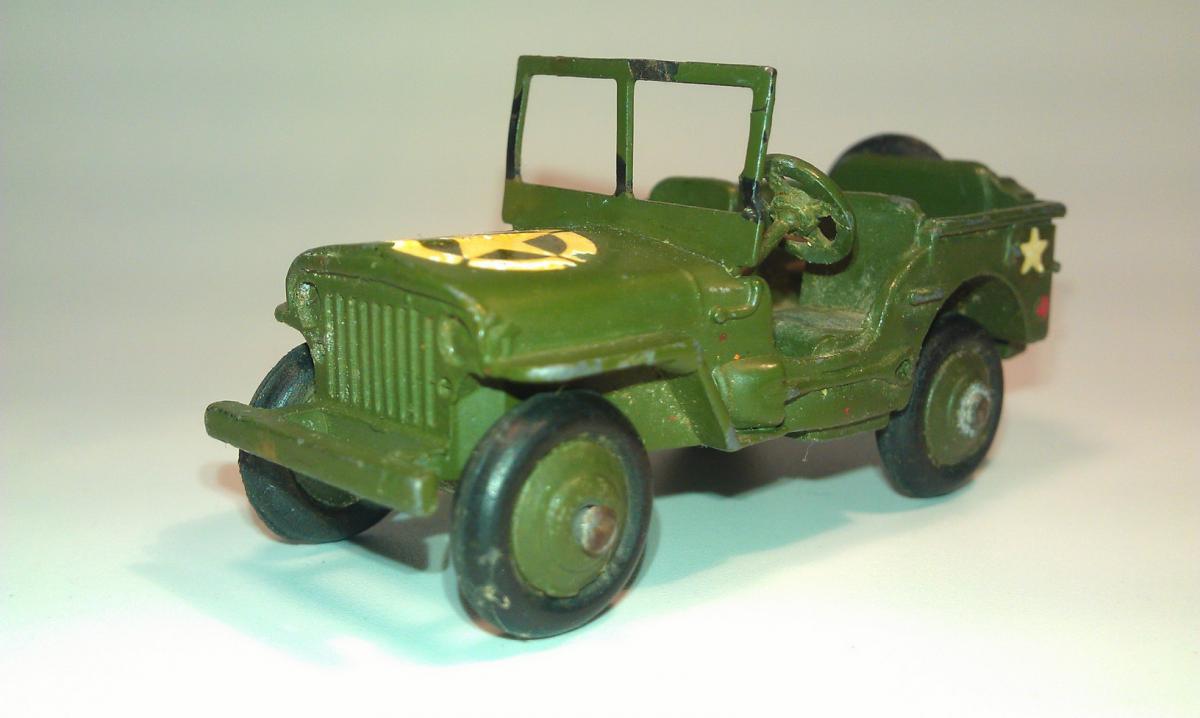
DT 672-153a U.S. Army Jeep final export issue 1952-55.
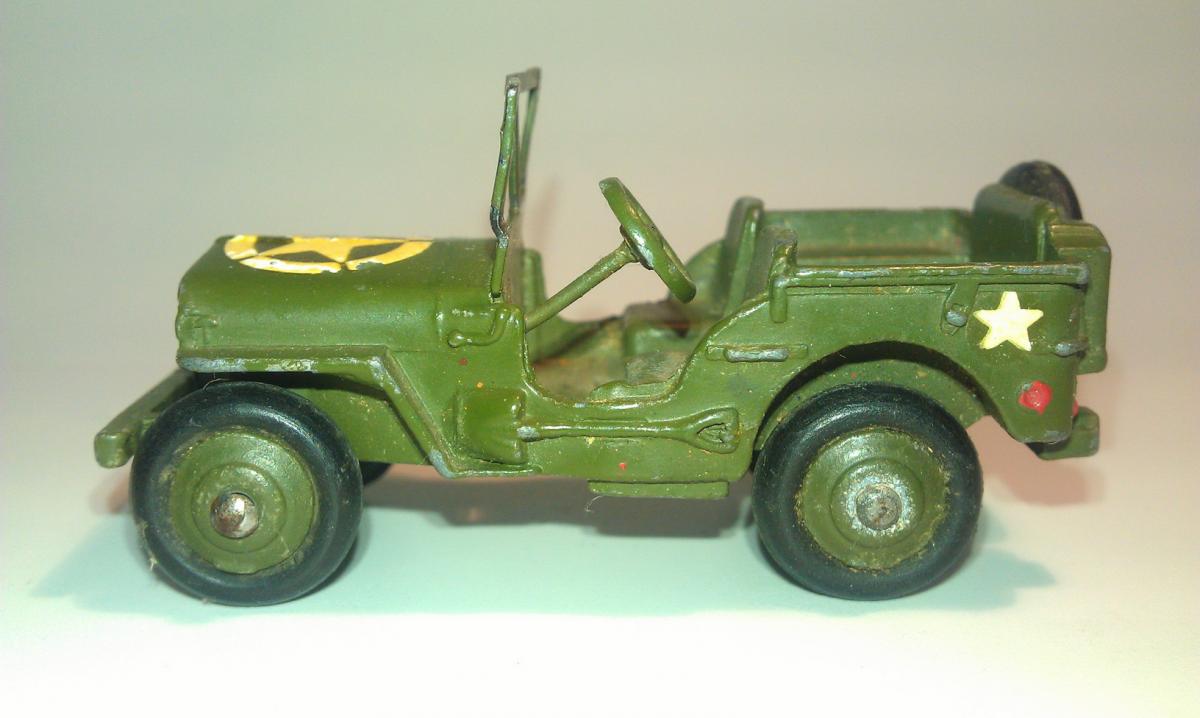
DT 672-153a U.S. Army Jeep final export issue 1952-55
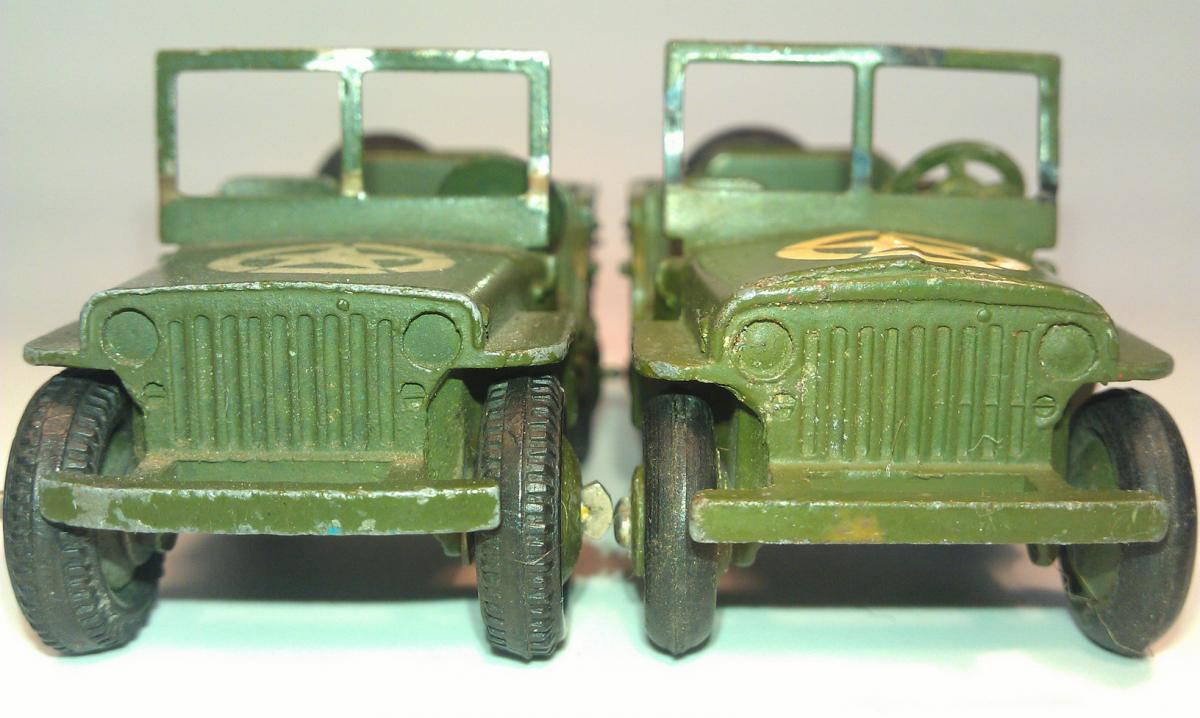
Left 153a 1st issue with flat bonnet - right 672 last export issue with raised bonnet.

Dinky Toys 672 Jeep base final US export issue 1952-55.
According to Keith Harvie in his excellent but short lived Binns Road Gazette n° 1 (1999) the variations are as follows ;
1) 1946 - First casting with flat bonnet and solid steering wheel.
2) 1947 - As above but with open steering wheel.
3) 1947 – 48 - raised bonnet center, flush ejector marks.
4) 1948 - as above but with raised ejector marks (the ejectors were too short or worn).
5) 1948 – 52 - as above but with circular painting ring.
6) 1952 – 55 - as above but with strengthening under the bonnet, flush ejector marks, crimped or domed, blued or regular axles. For export only.
Some other details worth knowing:
DT 153a Jeep was the first produced new model of Meccano Liverpool after WWII and appeared for the first time in MM of April 1946. It was first called Jeep and later on U.S. Army Jeep for the export version with sales number 672. It was never called Willys Jeep. Only later on the French 80B Jeep is called Hotchkiss-Willys Jeep. The 153a Jeep was only included in the Meccano price list UK from May 1946 till October 1948 and was never included in an UK or Dutch catalogue. It was included in the USA catalogues from 1947 till 1954.
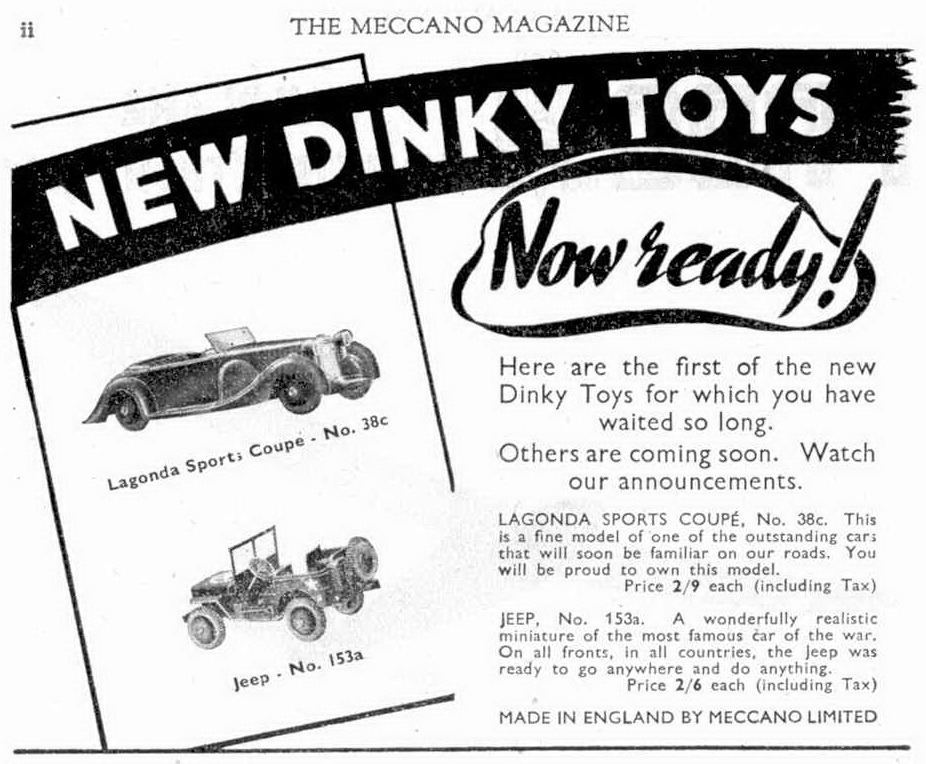
Meccano Magazine april 1946 with 153a Jeep. First new model of Meccano Liverpool after WWII.
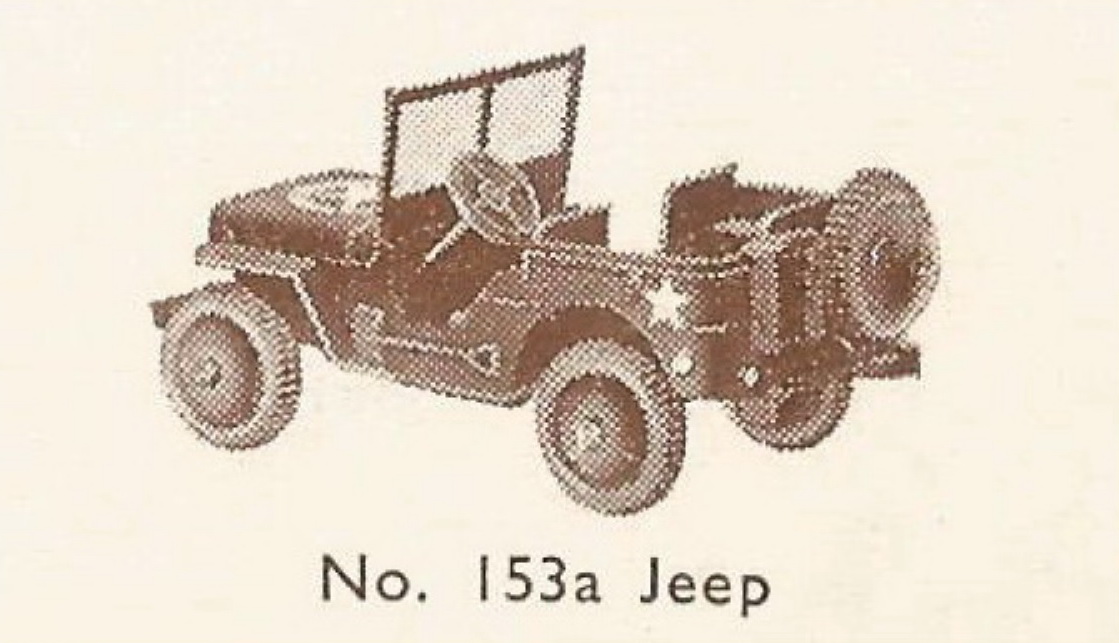
Meccano illustrated price list UK March 1947 with 153a Jeep. Note the 4 spoked solid steering wheel.
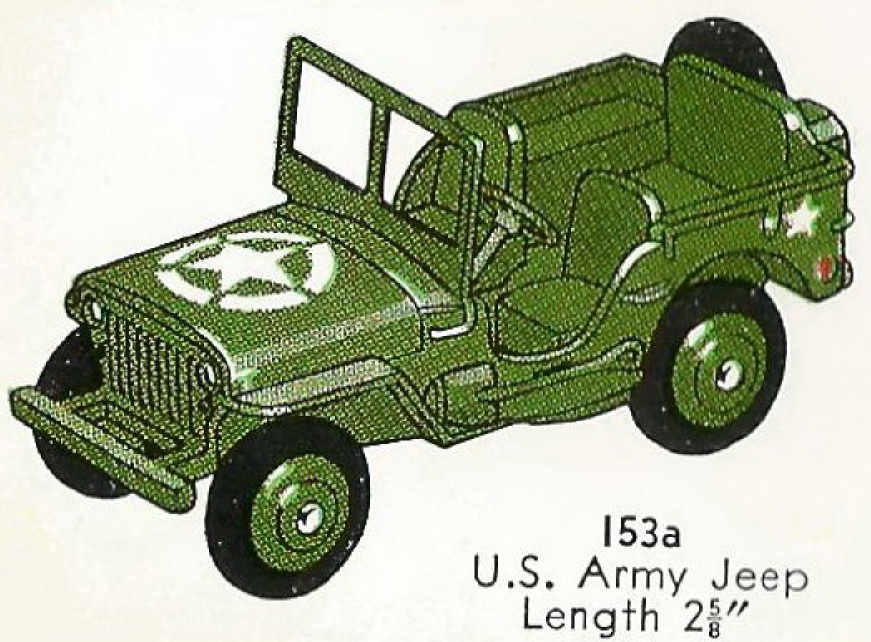
Dinky Toys catalogue 1953 USA with 153a U.S. Army Jeep. Note the raised bonnet and the rounded axle ends.
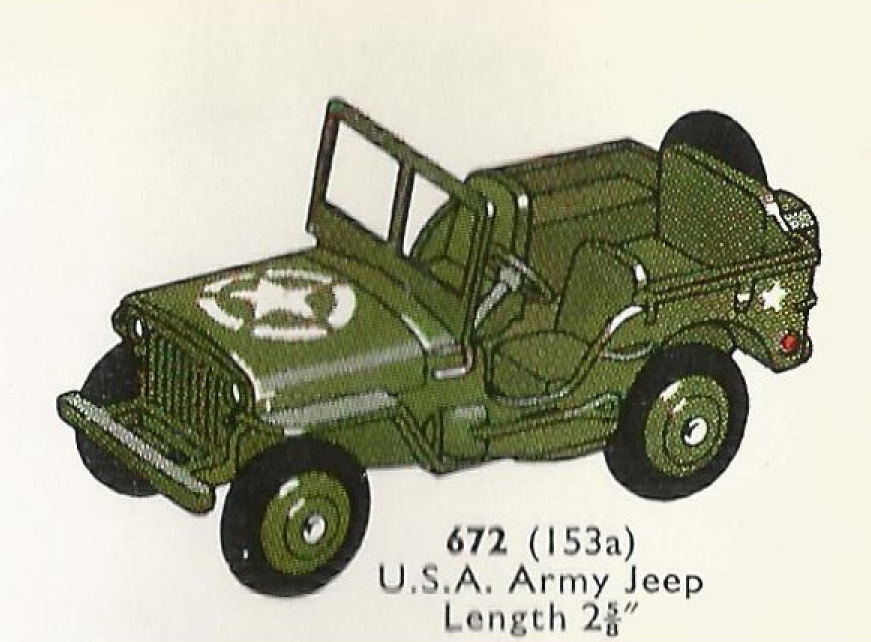
Dinky Toys catalogue 1954 USA with 153a-672 U.S.A. Army Jeep. . Note the raised bonnet and the rounded axle ends.
The name Jeep originated from the abbreviation GP (General Purpose), after which GP was pronounced as Jeep. It is one of the most remarkable and versatile military vehicles and a real hero in the WWII war scene.
Although you cannot find it anywhere in a Meccano Liverpool document, it is assumed that the Jeep model is based on the final 1942 version of the Willys MB ordered by the U.S. Government and manufactured by both Willys Overland Toledo Ohio and the Ford Motor Company Dearborn from 1942 until 1945.
During World War II, Willys and Ford built over half a million jeeps for the war effort, totalling 335.531 Willys and 277.896 Fords. The production was standardized and parts are interchangeable.
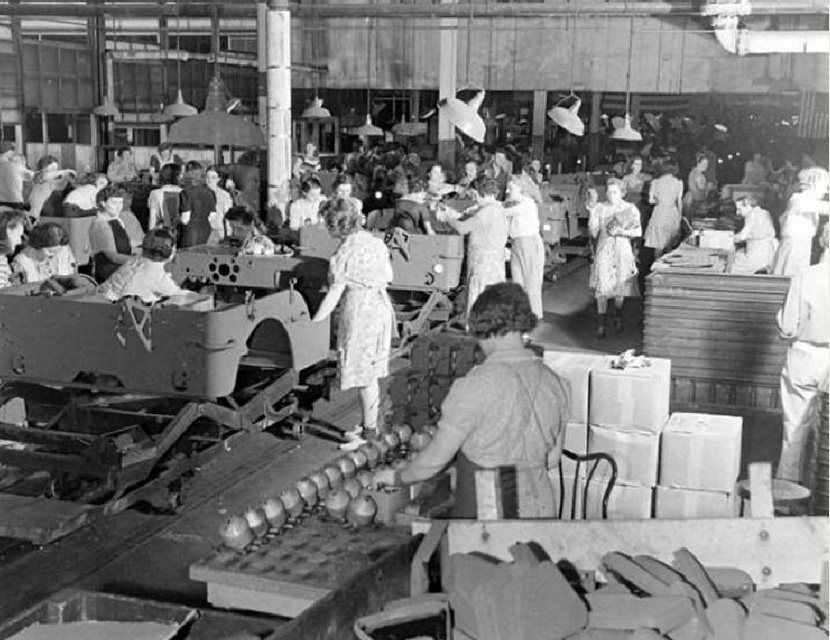
Willys Jeep assembly line in Toledo, Ohio. Remarkably many women are working there.
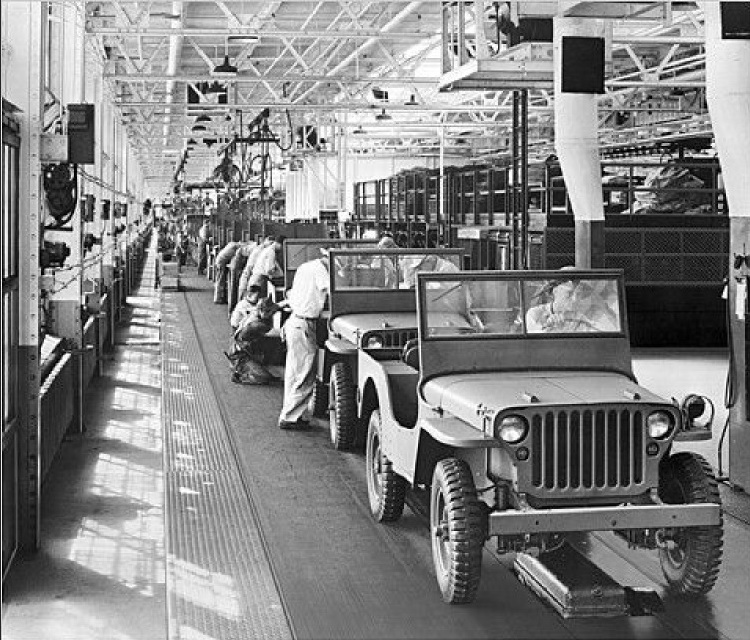
Jeep assembly line at Ford Dearborn 1941
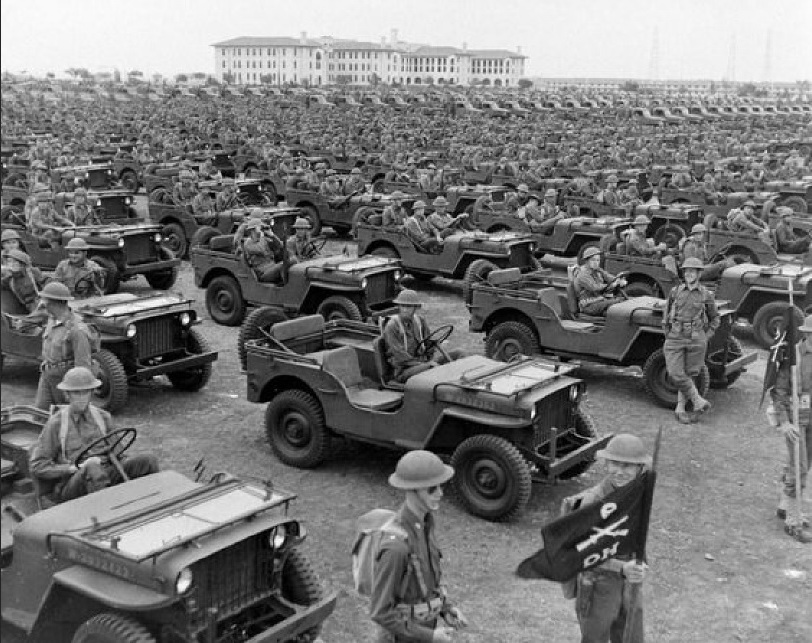
How many Jeeps do you want? Willys Jeep MB (with early slat grille). Army Day Parade Texas USA 1942.
Jeeps could be shipped overseas in crates, after which they were assembled in England. Jeeps were therefore stripped of wheels and some other parts and very ingeniously packaged together in a flat crate to take up as little space as possible for shipping overseas.
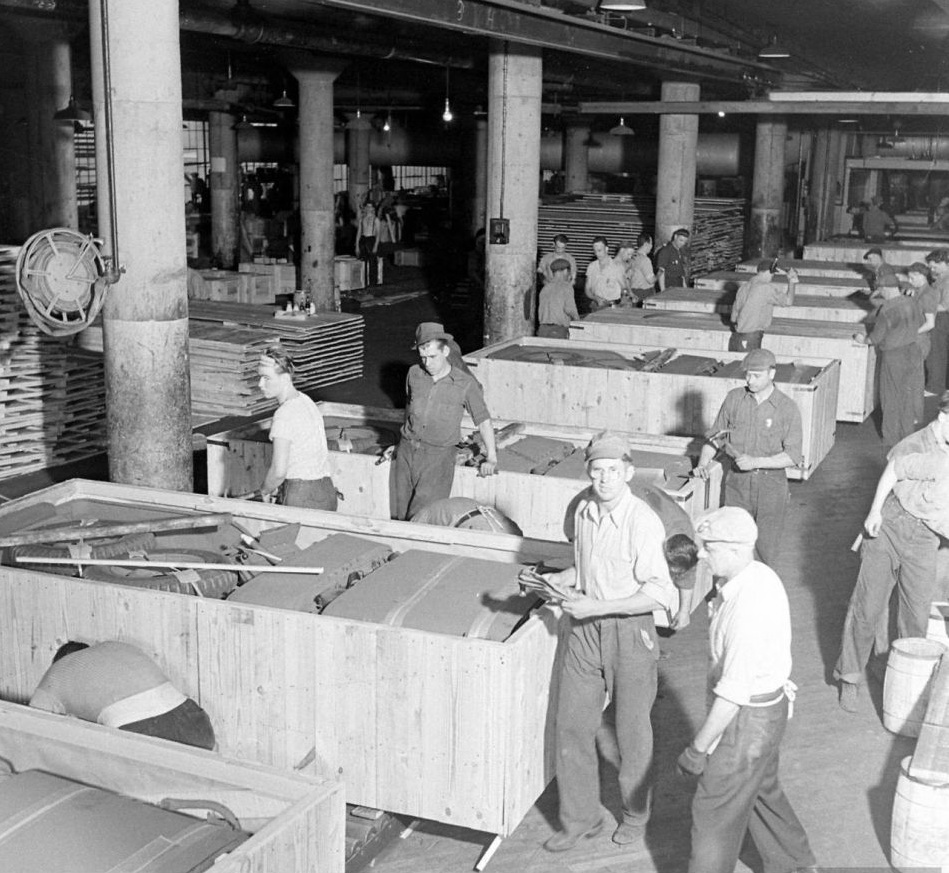
Willys Jeep MB prepared in crates for shipping overseas.
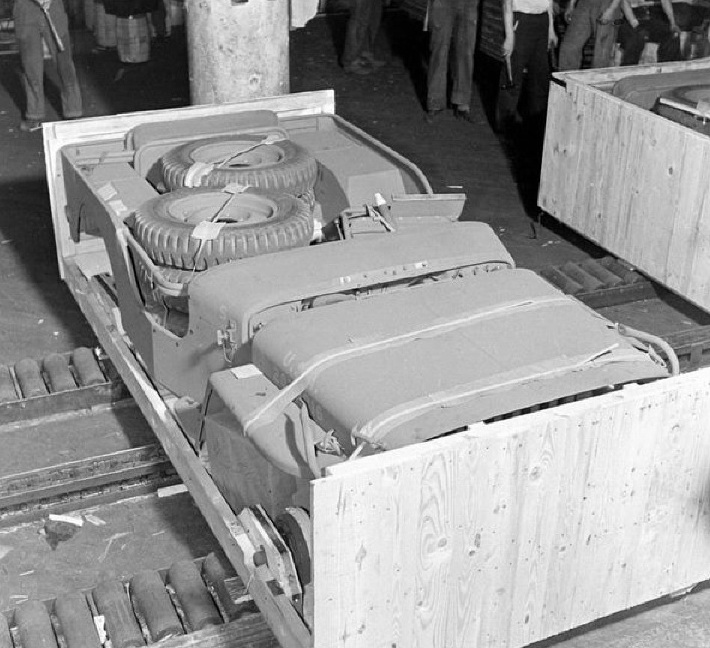
Willys Jeep MB in crate on the conveyor belt.

Ready for transport overseas.

On its way to England over the Atlantic.
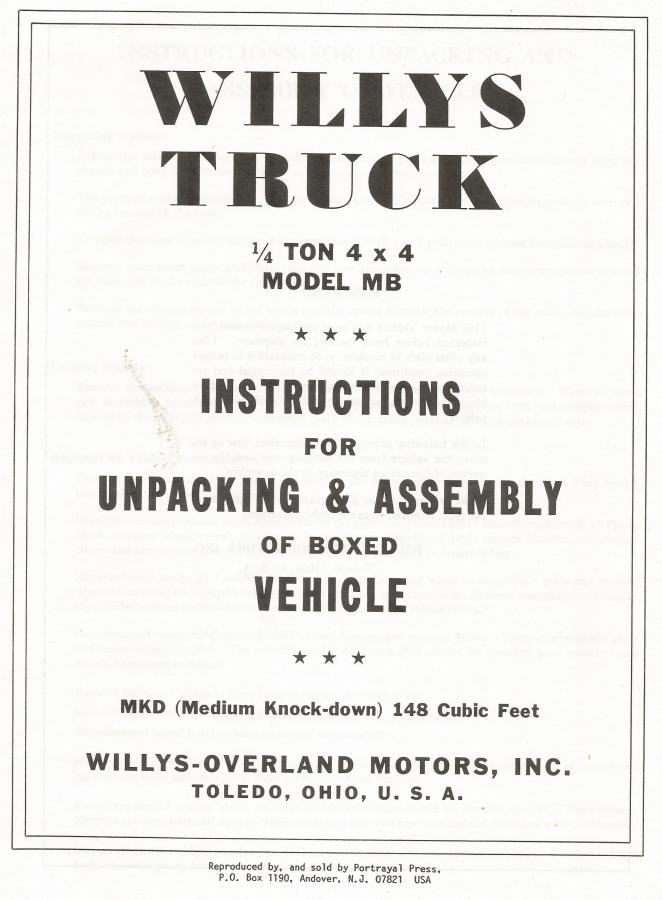
Instructions for unpacking & assembly of boxed vehicle Willys MB.
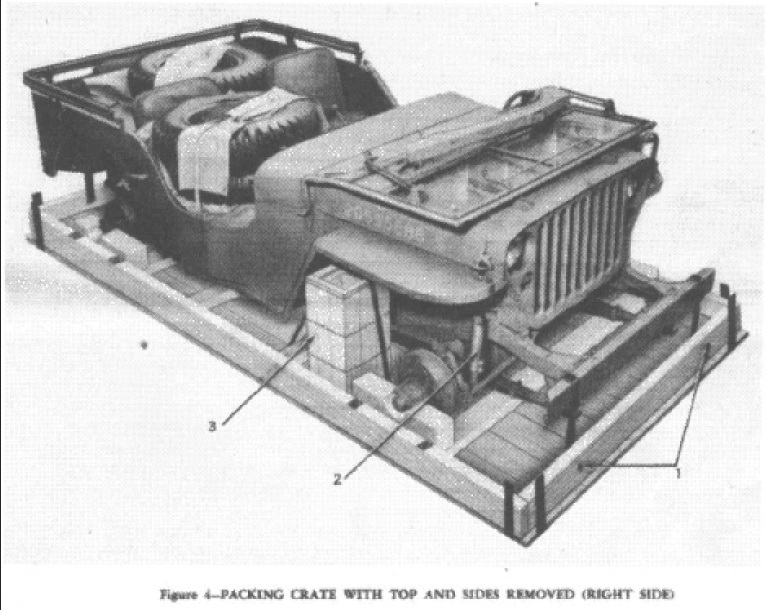
Willys Jeep MB partially dismantled, but complete in open crate.
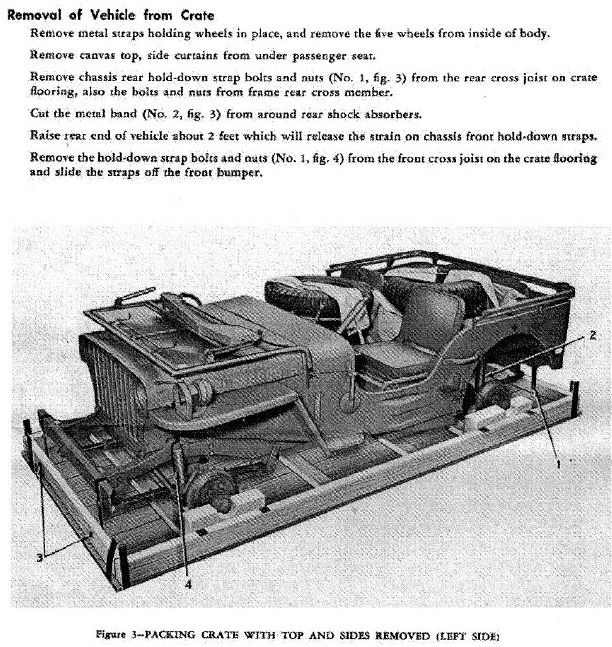

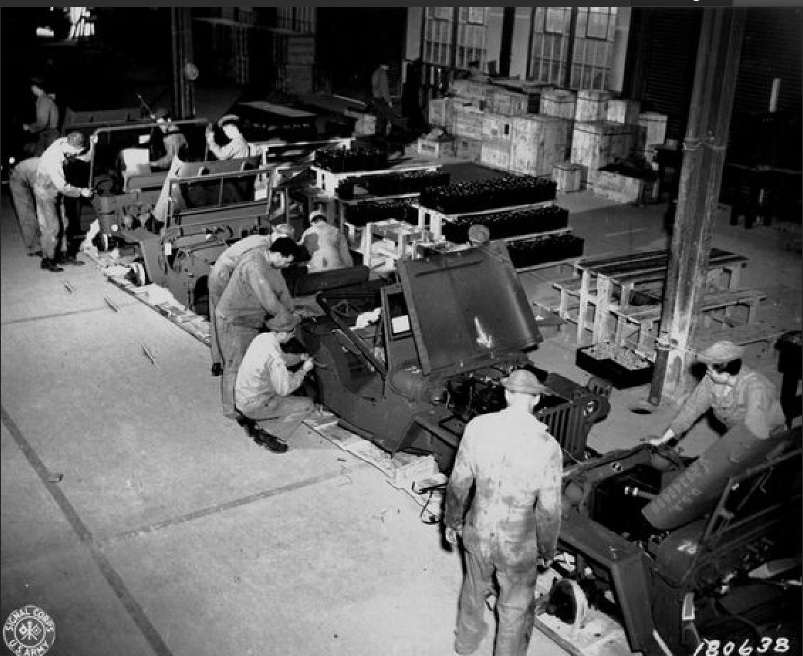
Willys Jeep assembly line in England.
This is a photo of Assembly Depot 0-640, Tidworth, Wilts, England taken on 8 September 1943. This is a facility that took jeeps from their shipping containers or preparation, after the trans-Atlantic journey aboard ship, and turned them into field-ready condition.
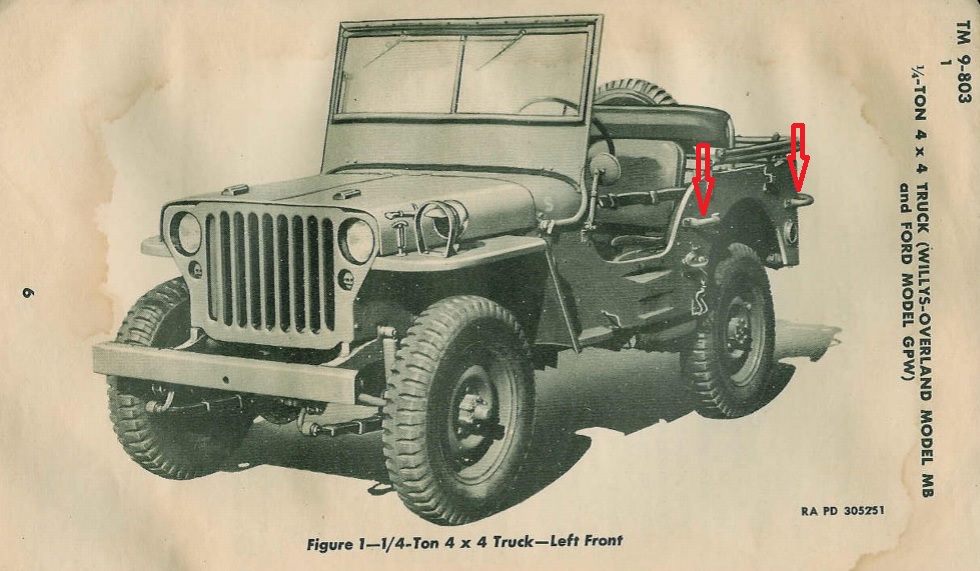
War Department Manual 22 February 1944 for Willys MB and Ford GPW.
Very recognizable are the 2 body handles on both sides of the chassis to lift up the body for assembling. Meccano Liverpool copied these handles very accurately.
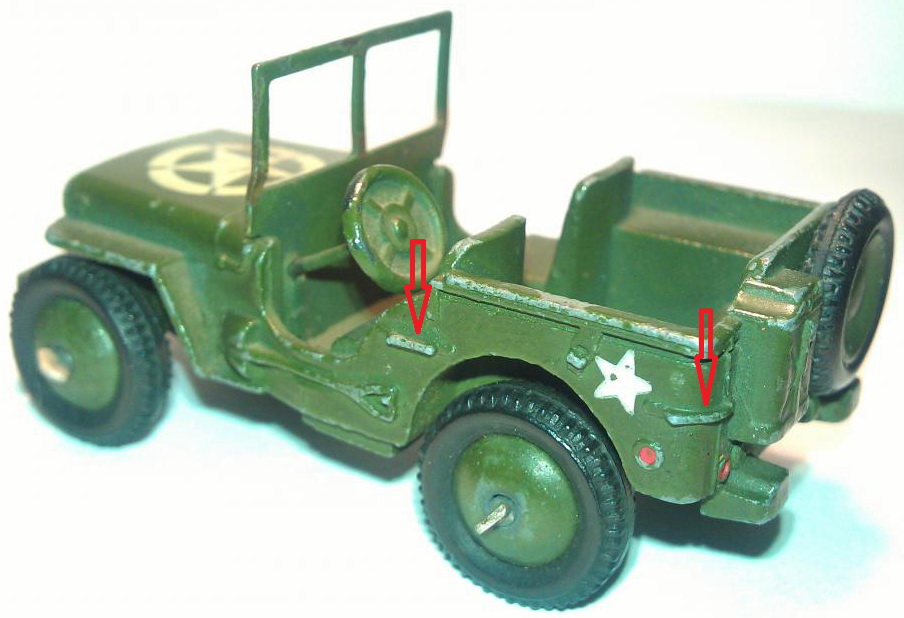
2 body handles on both sides of the body to lift up the body for assembling. Note the four spoked steering wheel of the 1st issue (and all later 153a-672 ones) DT Jeep above while the real Willys MB below has a 3 spoked steering wheel.
3 spoked steering wheel of the real Willys MB. Note the chassis plates on dashboard.
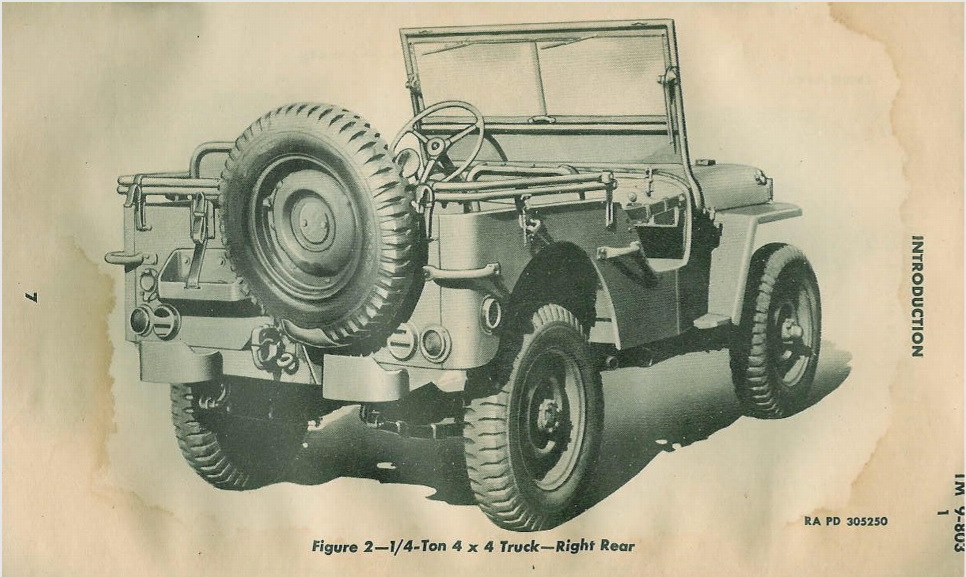
Willys MB and Ford GPW War Department technical manual 22 February 1944 Right Rear.
The production was standardized and parts are interchangeable.
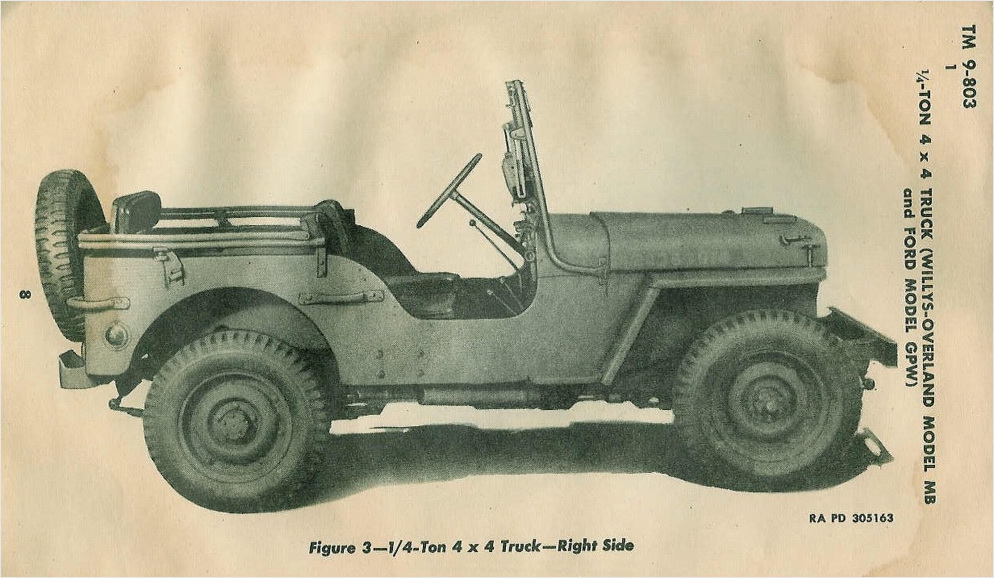
Willys MB and Ford GPW Right Side.
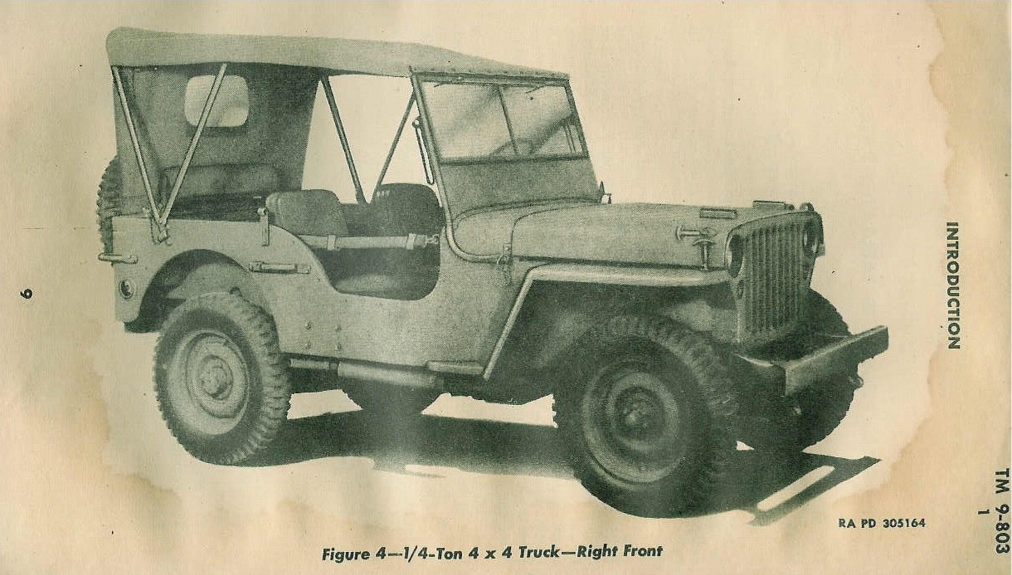
Willys MB and Ford GPW Right Front.
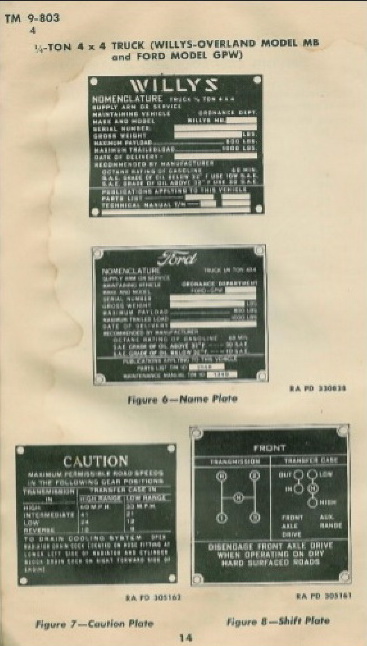
Dashboard chassis plates Willys and Ford.

Anatomy of the Wartime Jeep.
Finally, here is a link to a short video about the mass production of Willys Jeep in WWII:
https://www.youtube.com/watch?v=t0RlWq_dsn0
Jan Oldenhuis, 3 April 2018.
Upon further investigation, the DT 153a Jeep also appeared in the Meccano catalogue of Argentina of February 1948 which I received as a gift from Jose Heraud.
As on my image above from the illustrated Meccano price list UK 1948, it is striking that also in the catalogue of Argentina the tires are pictured white, instead of black. Would Jeeps after all have been issued with white tires at the beginning of the production? or is it a mistake in these 2 !!! drawings?
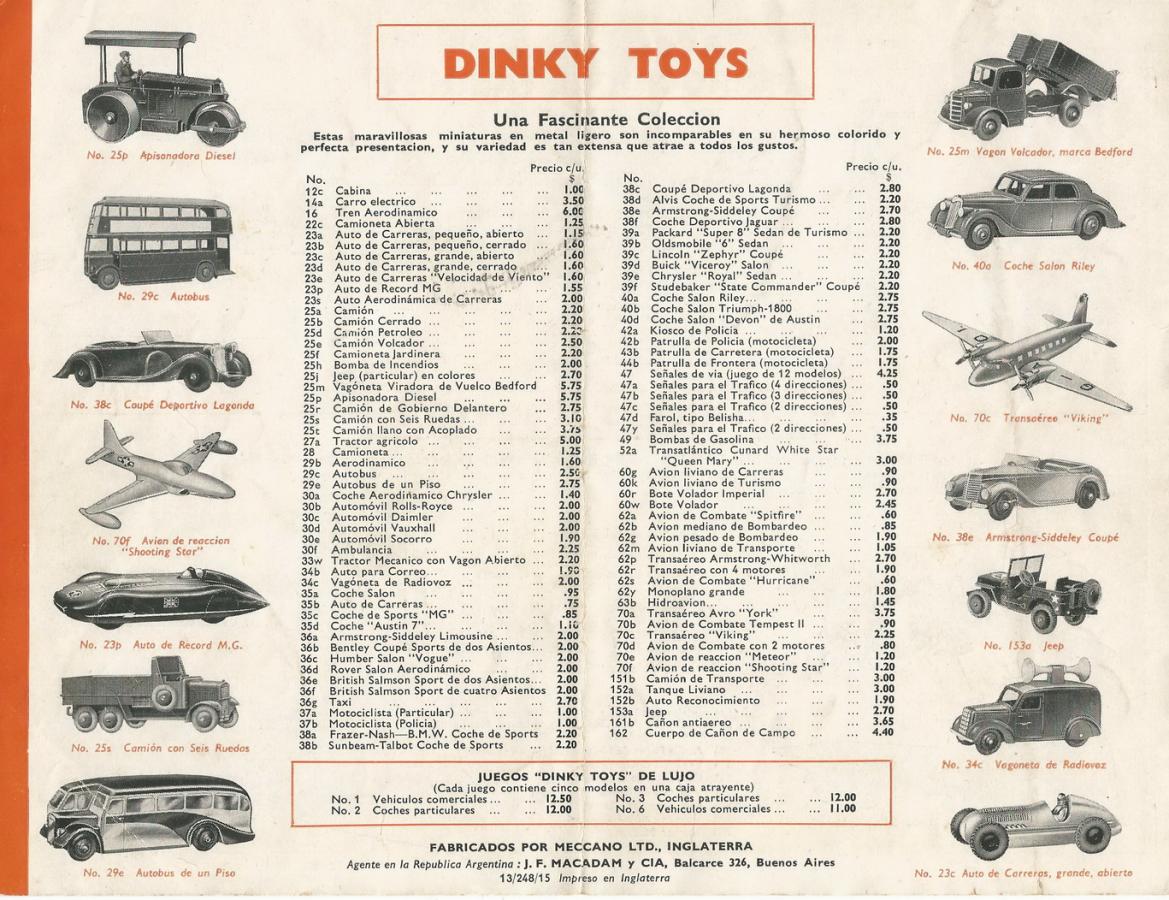
Meccano catalogue Argentina February 1948 with 153a Jeep with white tires.
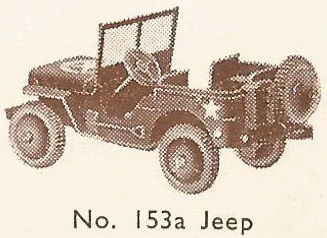
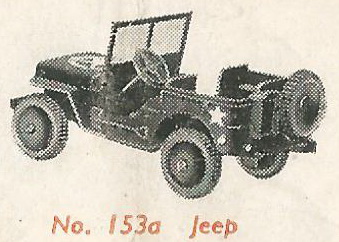
Meccano price list UK March 1947. Jeep with white tires. Meccano catalog Argentina Febr 1948. Jeep with white tires.
Jan Oldenhuis, 4 April 2018.
Jan---Very interesting, however I think that some time ago, Jan Werner posted about his very early, post war Reconnaissance Car, which I think also had those finely treaded, white tires. They certainly look a little out of place on a military vehicle, but sure are interesting, and I would also think, somewhat rare today.
Best regards, Terry
I presume that especially in the post-war period mid-1945 - mid-1946 many models were fitted with white tyres, both smooth and treaded, possibly pre-war stock of tyres, that the factory had to get rid of. The example Terry refers to below, and another well-known contemporary with smooth white tyres. I have no picture evidence available, but by heart I remember examples of the early post-war Jeep and the AA Gun fitted with white tyres (and of course many civilian vehicles). Perhaps others have pictures available of the no. 153a Jeep with white tyres? Kind regards, Jan
Terry and Jan, thank you very much for your very welcome contribution. It relieves me of a certain uncertainty about the existence of white tires for the early 153a. Now that I have received confirmation from you that this is certainly possible, I dare to confess that last night, when searching for images of a 153a, with a good Dutch acquaintance on Ebay I found and bought an early 153a with white tires. I found this find so special that I made the decision for myself to buy it, also thinking of the fact that my early Lagonda was issued simultaneously with the 153a and also had white tires. I have not received it yet, but I already show you the pictures of Ebay here. I am very happy that this kind of questions can be discussed here.
Kind regards, Jan O
Today I received my 153a Jeep 1st issue 1946 (my birth year) with white tires. He is now showing off with my 38c Lagonda 1st edition with white tires in the display cabinet. Together they were also issued by Meccano Liverpool as 1st models after WWII. So they should stand together and a wish of mine is fulfilled. Like the song of Mitch Miller in the 50's: "Happy Days are Here Again."
Jan Oldenhuis, 7 April 2018.
Jan—-Great find! You don’t see these come up for sale very often, so great you found a nice one. I have a few very early post war Dinky’s with white tires, but no military. As Jan has suggested, those old, soiled white tires clean up very nicely and safely with just a toothbrush and water, and mild scrubbing.....very nice!
Best regards,
Terry
Great find, Jan, this earliest version! Lovely model with those white tyres. 'Would benefit from some gentle cleaning', as they say![]()
Kind regards, Jan W
Jan and Terry. Many thanks for your kind comments and good recommendations.
I always leave my purchased items as much as possible in the condition as I have bought them. I personally find that the most authentic way to show how they can look after so many years and that they are just old. Of course I also have mint copies, as if they are new from the factory. I also like that, of course. I find originality of the state of discovery very important. At most I clean them gently with a cloth or with a small soft brush to remove the dirt or dust. Personally, I do not need to wash them and make them new again, because they simply are not. Like me, he is 71 years old and I am not as handsome as when I was 20 ![]() (see attached photo with yellow arrow of the very pleasant meeting of Dinky's friends on 5 August 2017 at Jan Werner's home in Monnickendam), but I still enjoy every day. Note: the date and time of the picture is not correct. Maybe Jan Werner can fill in the other names.
(see attached photo with yellow arrow of the very pleasant meeting of Dinky's friends on 5 August 2017 at Jan Werner's home in Monnickendam), but I still enjoy every day. Note: the date and time of the picture is not correct. Maybe Jan Werner can fill in the other names.
Kind regards, Jan Oldenhuis, 7 April 2018.
I agree ... but you also take a shower every now and then, don't you, Jan?![]()
For reasons of privacy I deliberately did not mention names when I posted this photo last year.
But if you like I could send them to you by private email. Kind regards, Jan W
Jan....that is so funny you mentioned the shower.....I had thought of the exact same example, but realized he has his own views on this. I have thoroughly dusted my older models, that were quite dirty, to very good effect, and also need to go back and clean some of those white tires. Even though those white tires are not realistic, at least on military vehicles, I still like them, especially on those mid-1950’s French automobiles, where, with the shiny wheels, they provided a classy look. However, I did not like those heavy treaded white tires, used by the English Meccano factory, in the late 1950’s. To me, they looked totally out of place on the cars, and was one of the main reasons I lost interest in collecting them around 1959-1960.
Yes Jan. I agree with you. It was in my enthusiasm a little ill-considered, but it is better so. Most of them I know. Many thanks.
Kind regards, Jan O.
Terry, we share exactly the same wave length on this! Regards, Jan W
I understand your reasoning of both, but I do not know the effect of water on the star on the bonnet, or it let loose. That's why I dare not give the car a water bath in this case.
Jan O
Jan, the transfer will not come off after so many years when operating carefully. Try and remove the loose dust with a dry medium stiff brush first, then proceed with the brush and/or a cotton bud, dipped slightly in tepid water to which a tiny little bit of soft soap has been added. Strike gently (and from the centre to the edge on the star transfer). It will do (your cotton bud will turn ‘black’). The tyres can be done with clean tepid water, also to be used for the second, final cleaning action of the model. Wipe off and dry carefully, with a soft cloth and/or dry cotton bud, and finally on the air. Test on hidden places first. Soaking it in a ‘water bath’ is neither necessary nor desirable in my opinion. Choosing for cleaning or not can be a matter of taste or principle, but it is not impossible that after many more years of influence the caked dirt can do more and more harm to the quality and colour of the paint finish. Kind regards, Jan W
Jan. Thank you very much for these excellent directions. I'm going to work with it. Thanks.
Kind regards, Jan O.
Jan O.——I totally agree with Jan W’s suggestions on how to clean your old Dinky Toys. I have used very similar techniques for gently cleaning many of my older Dinky’s, and find using either the cotton bud or soft bristle brush dabbed in a little water works wonders.....especially in removing old dust or grime that has settled into crevices, that are hard to rub with a cloth. I also find an old toothbrush, soaked in water, works very well on cleaning tires. No need to get the model real wet. Good luck!
Best regards, Terry
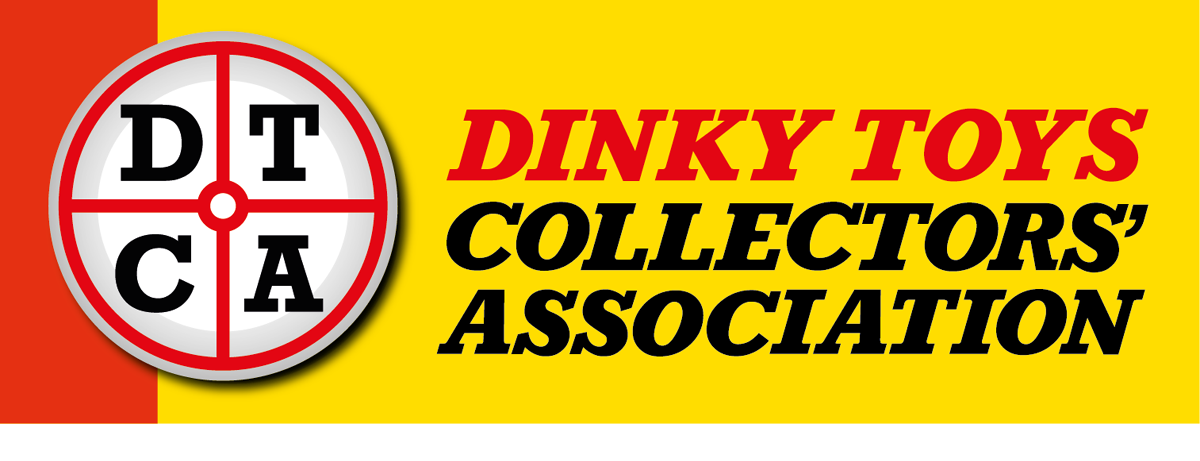

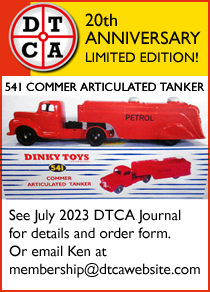
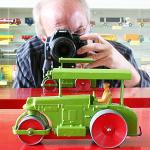
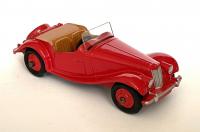
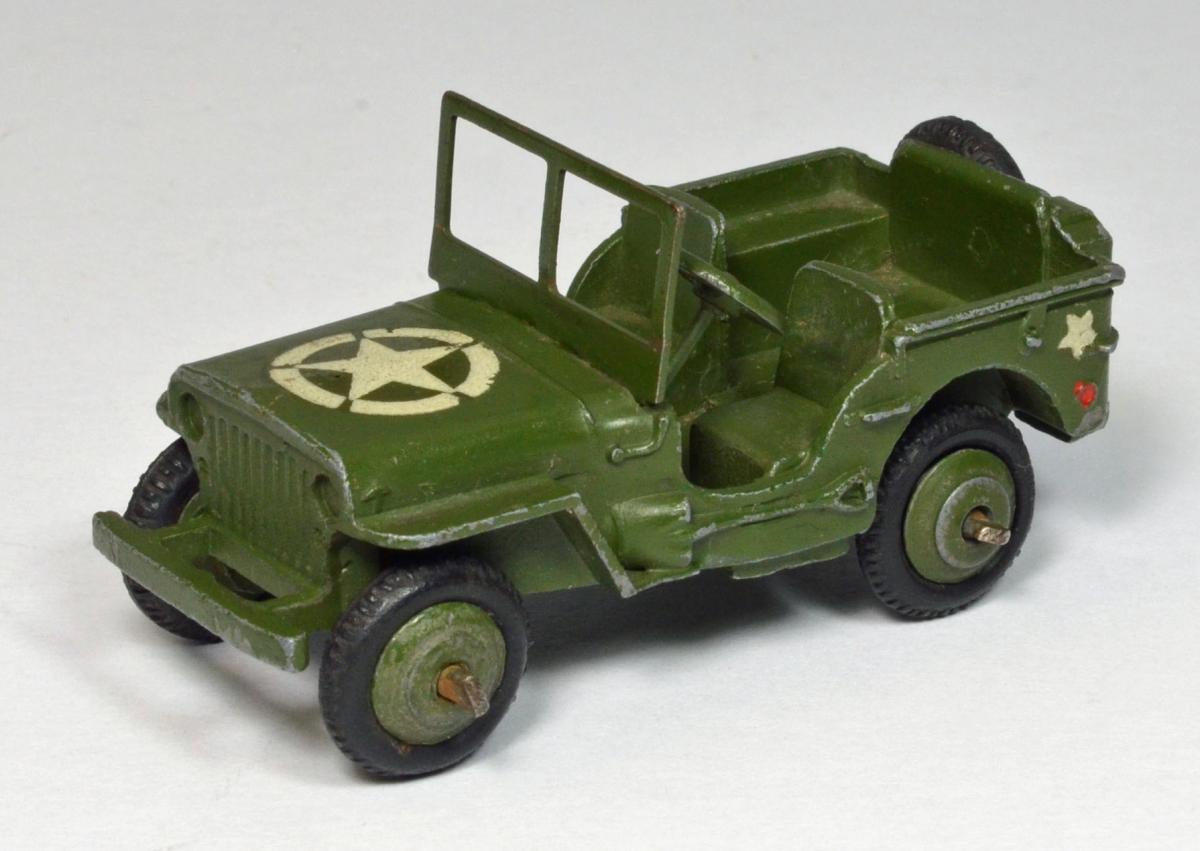


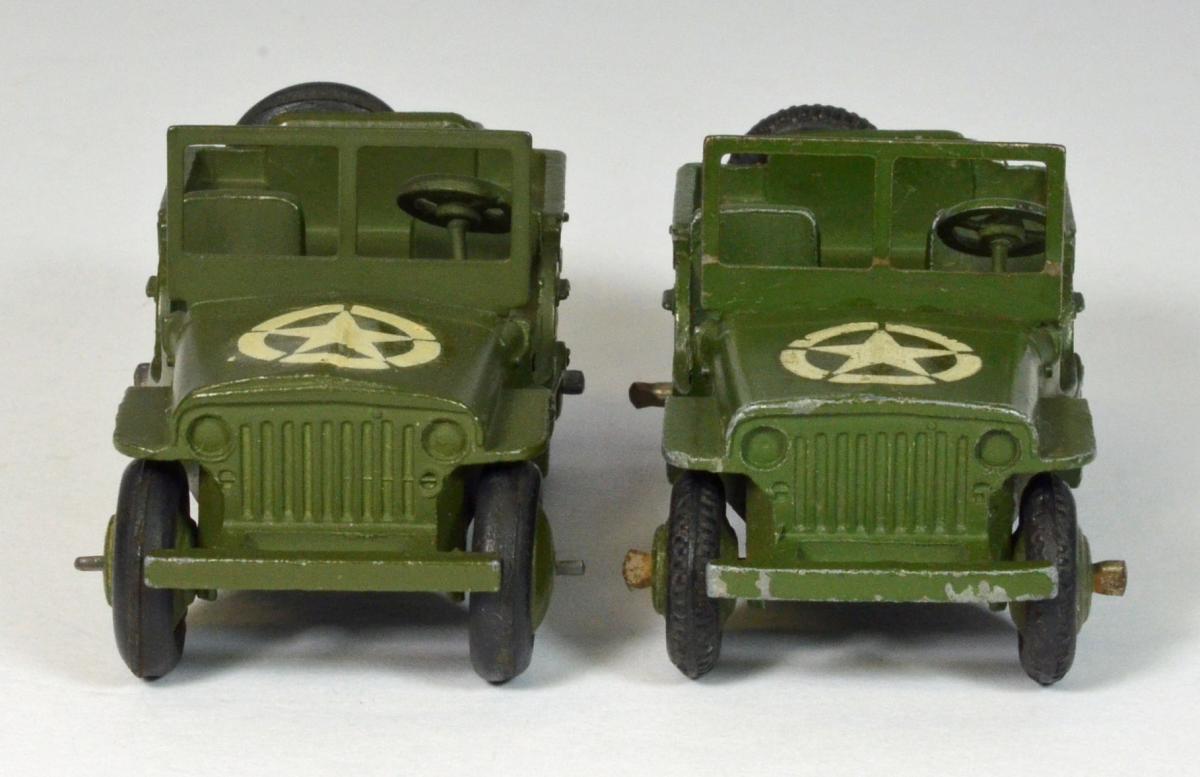


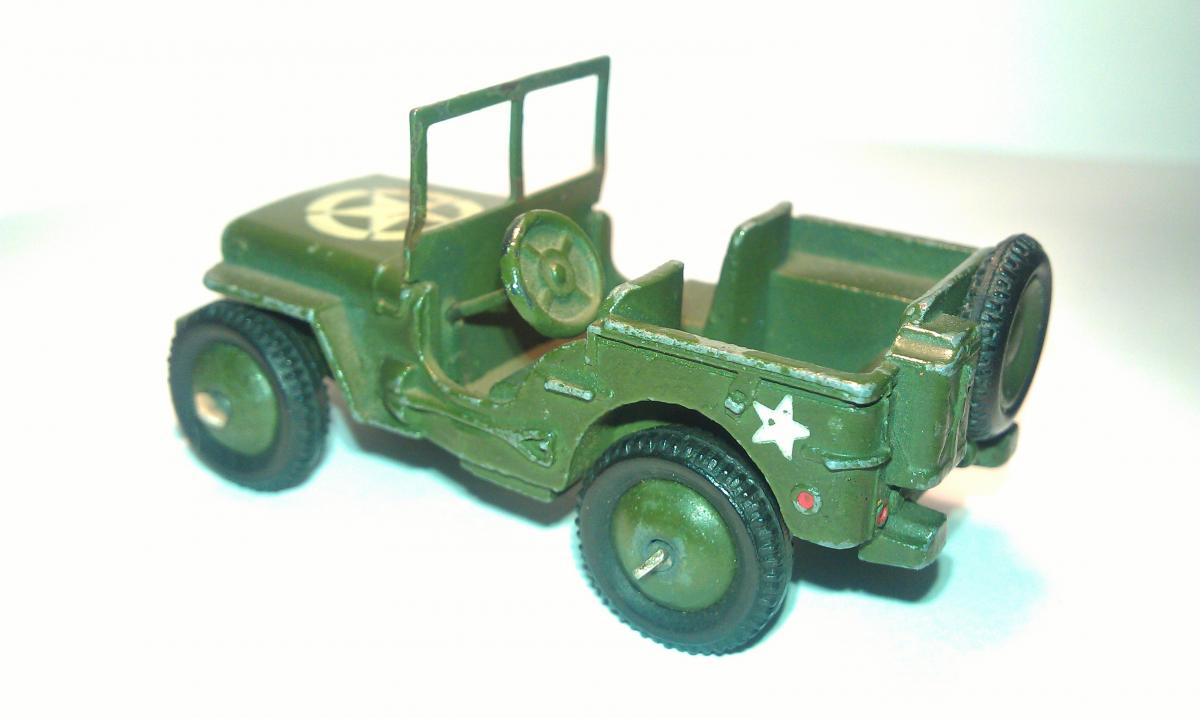
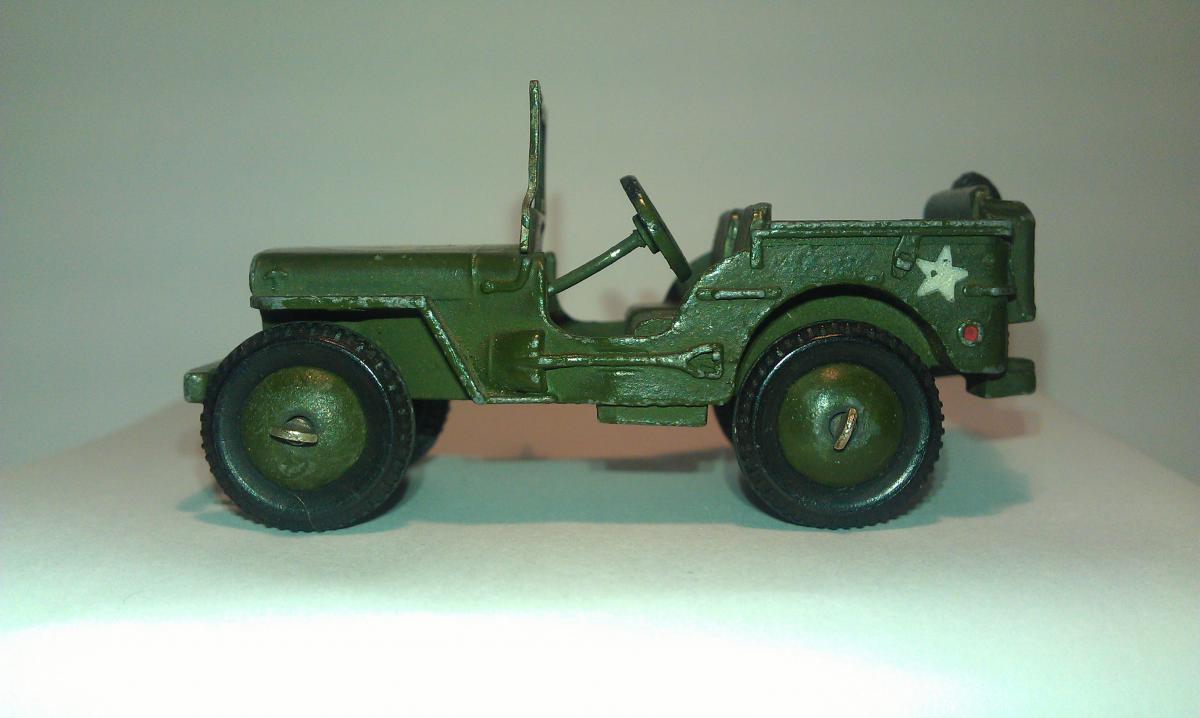
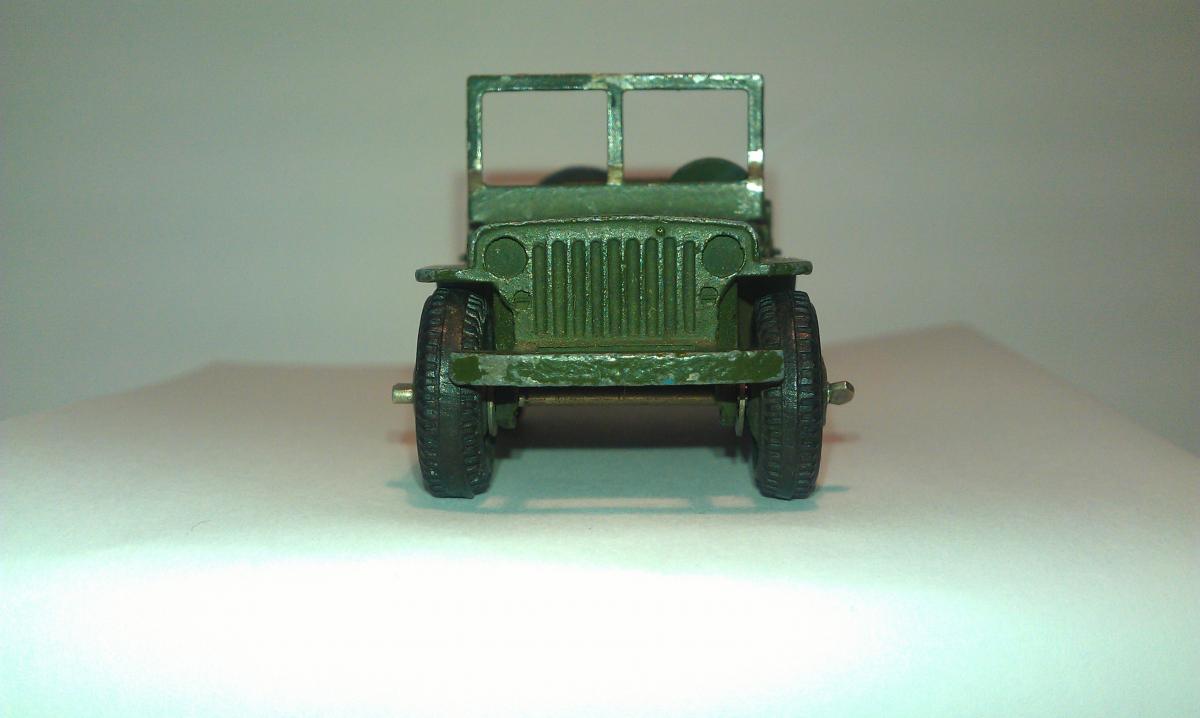
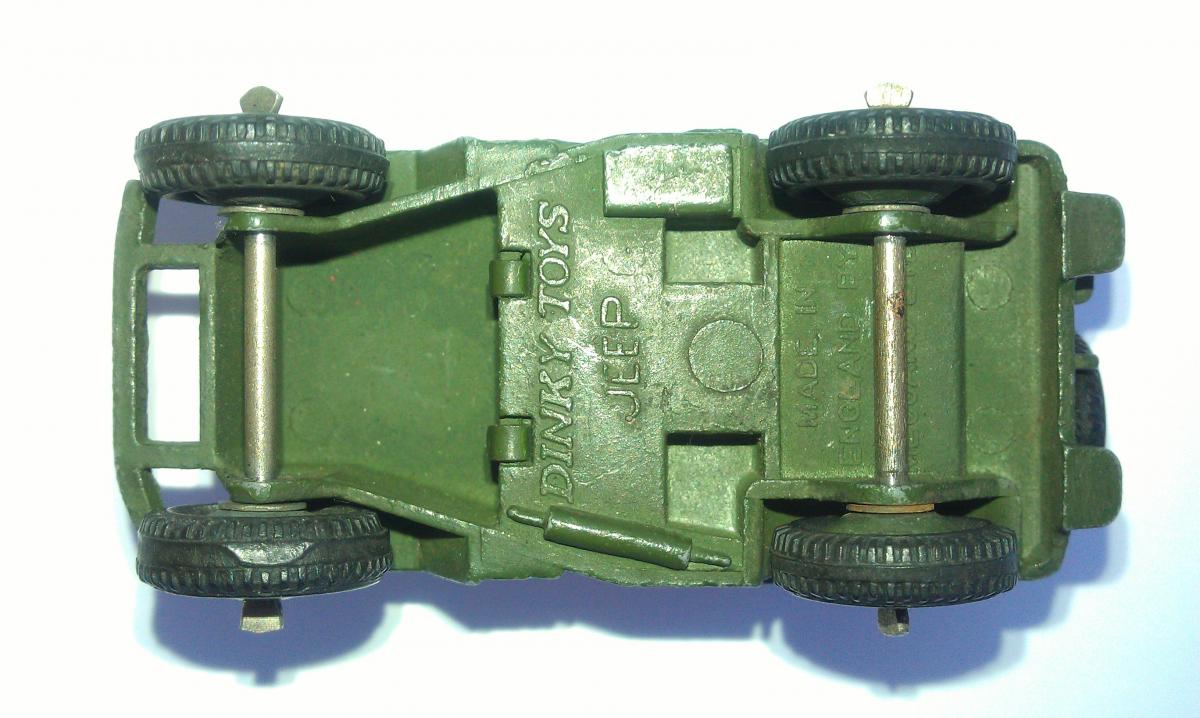
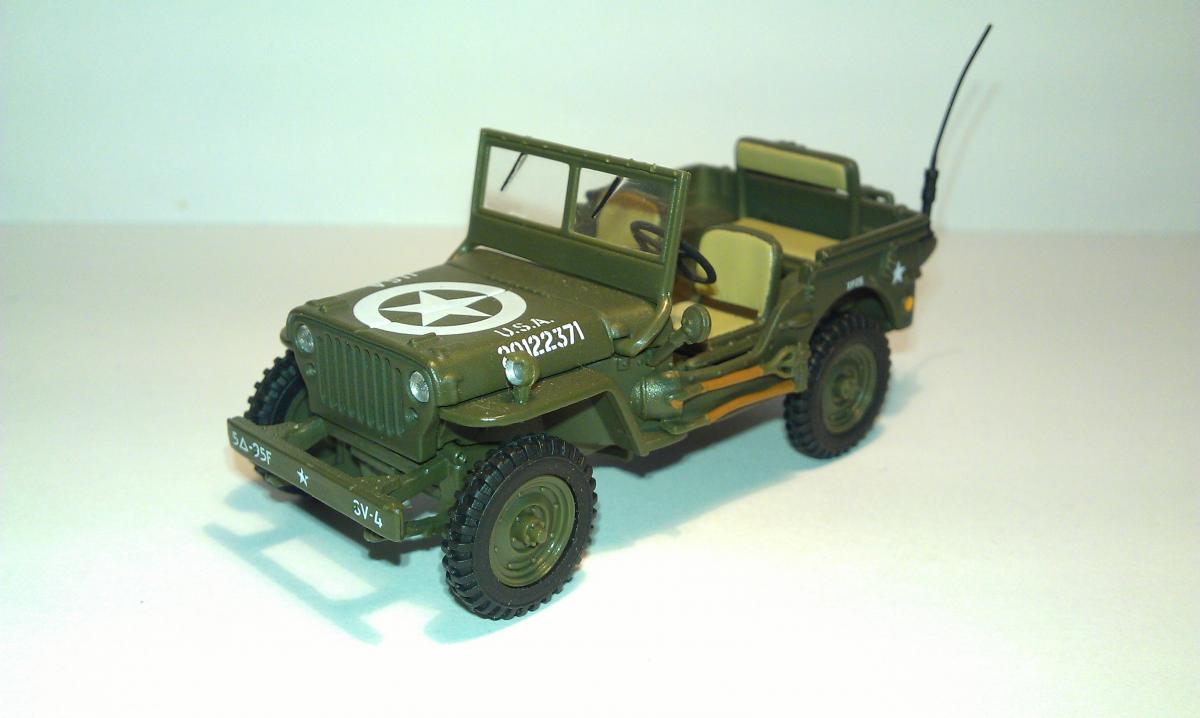
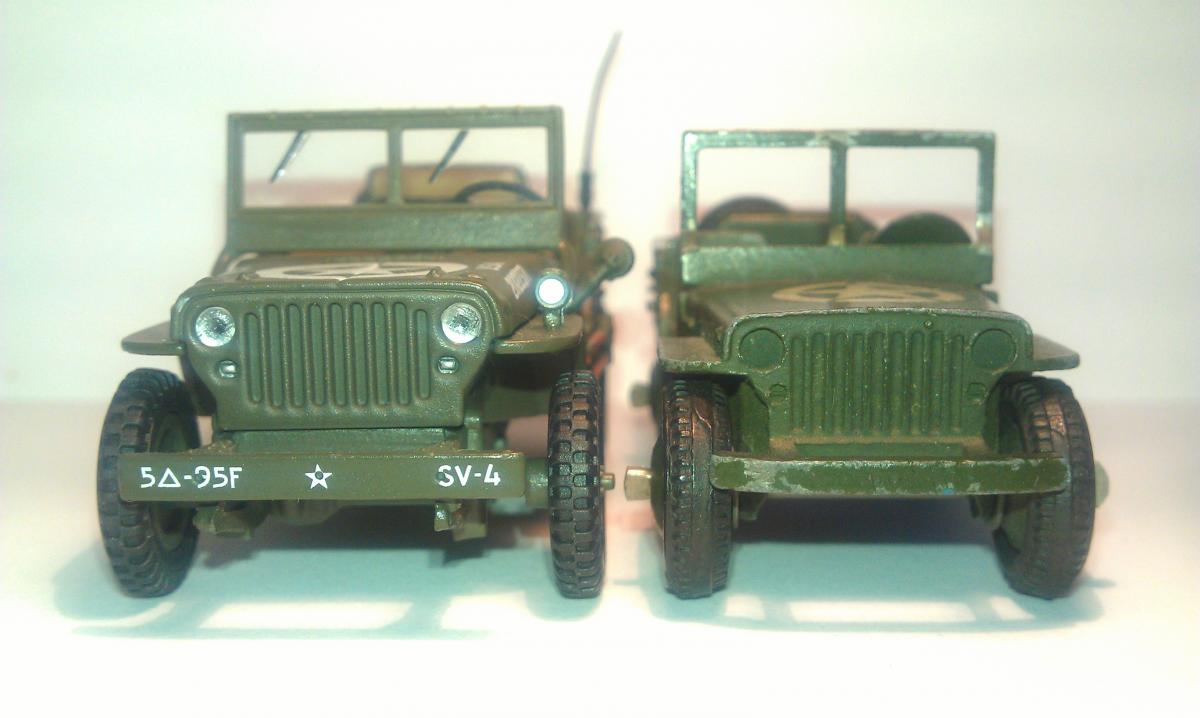


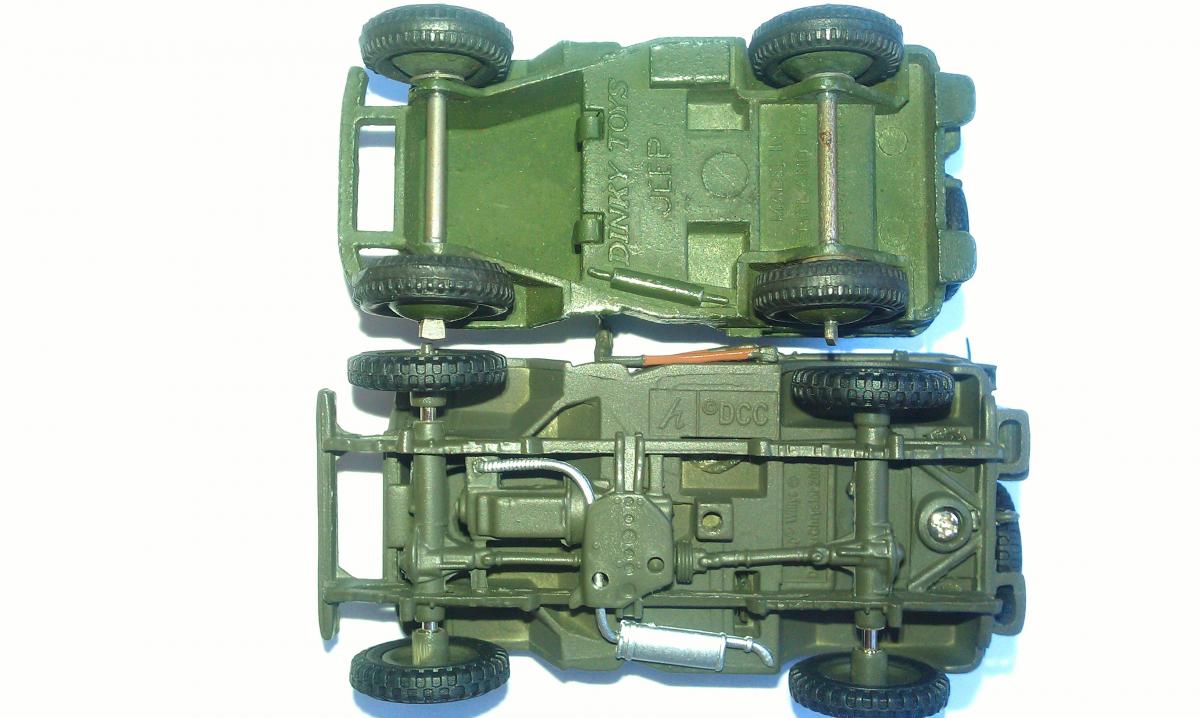
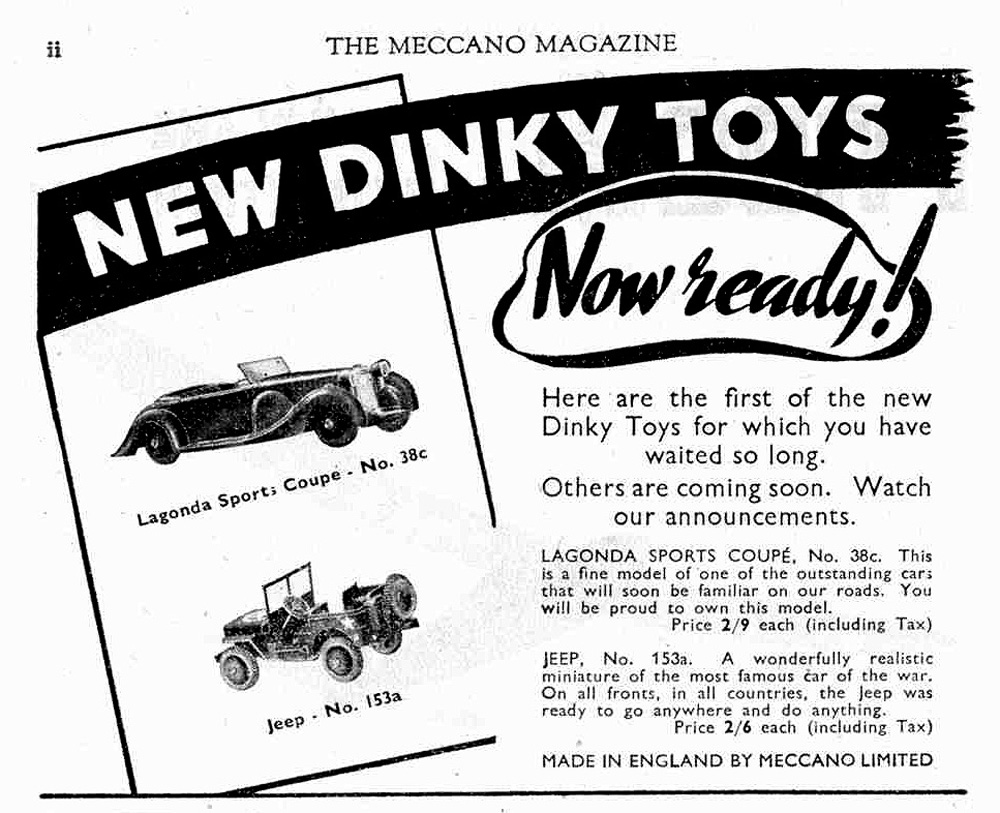
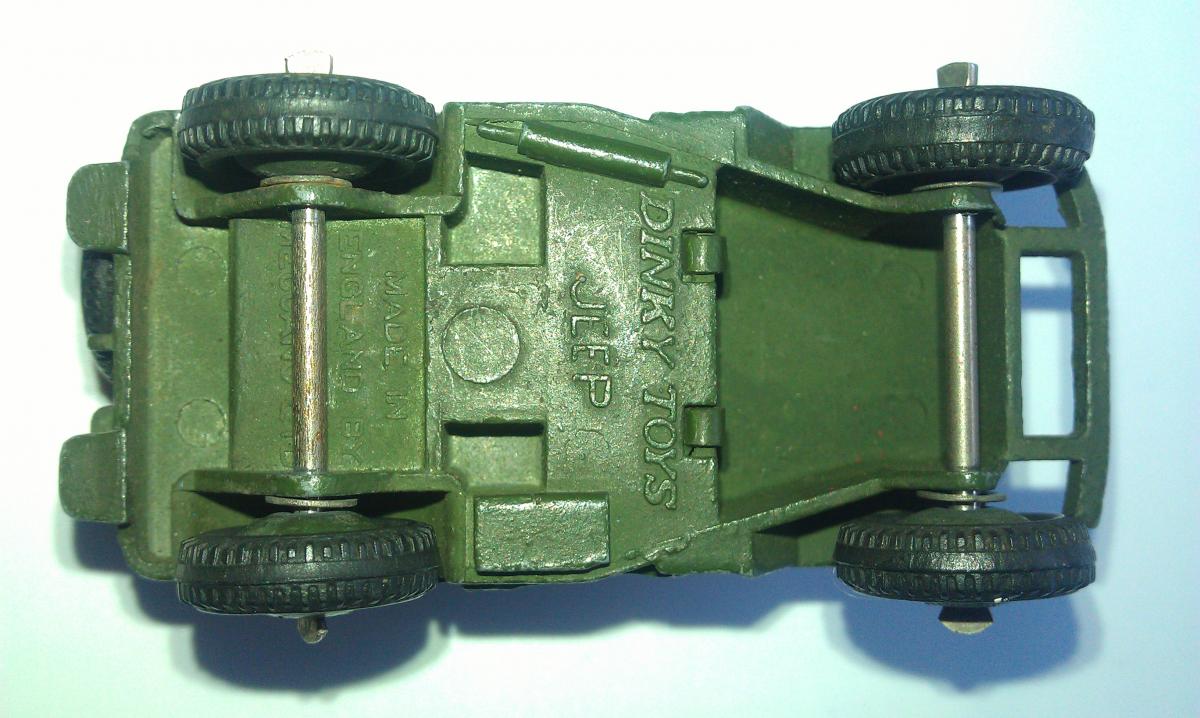

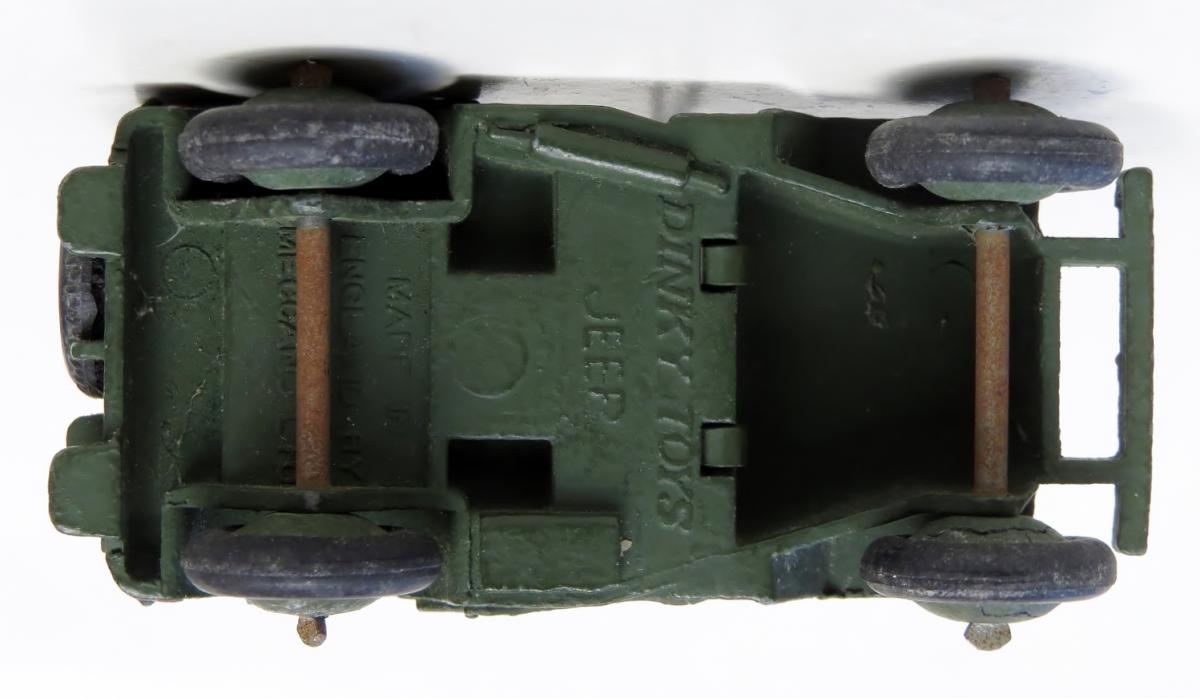


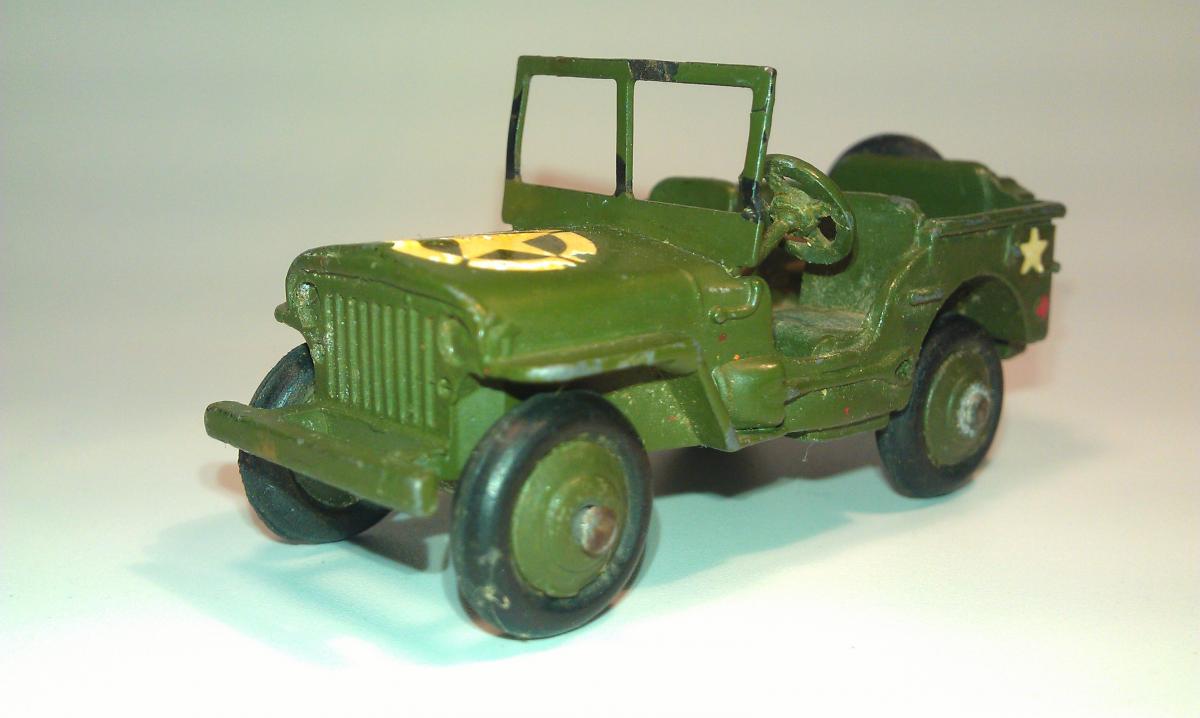

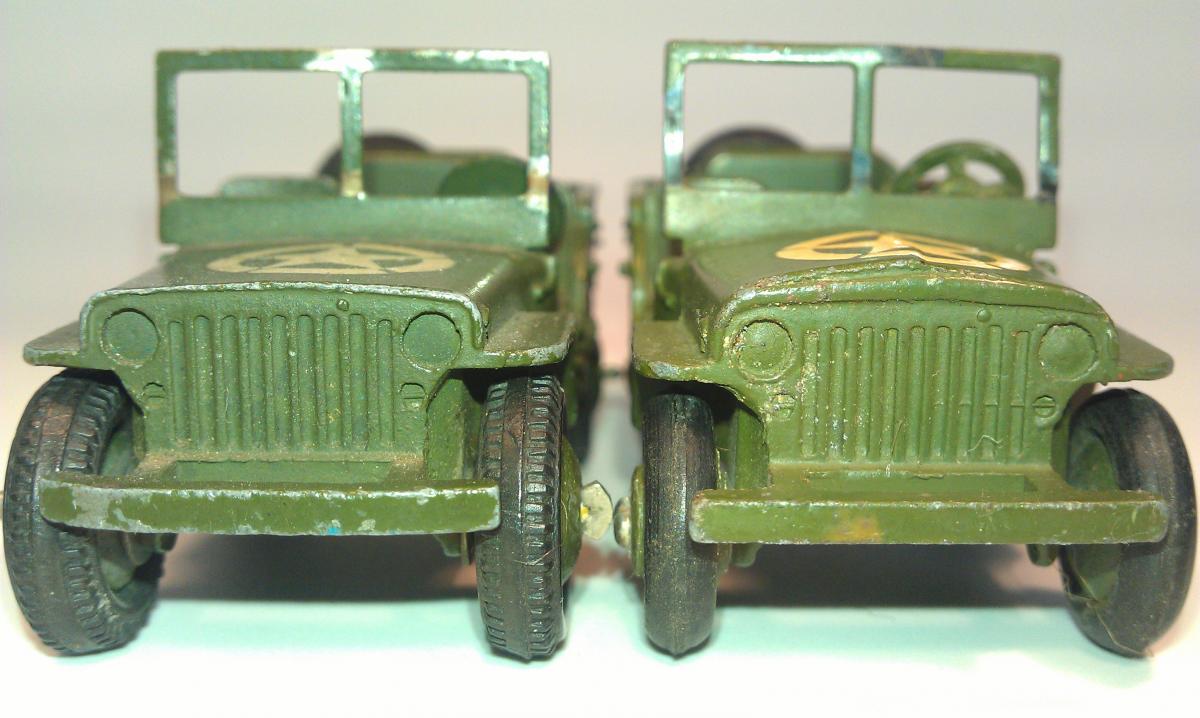

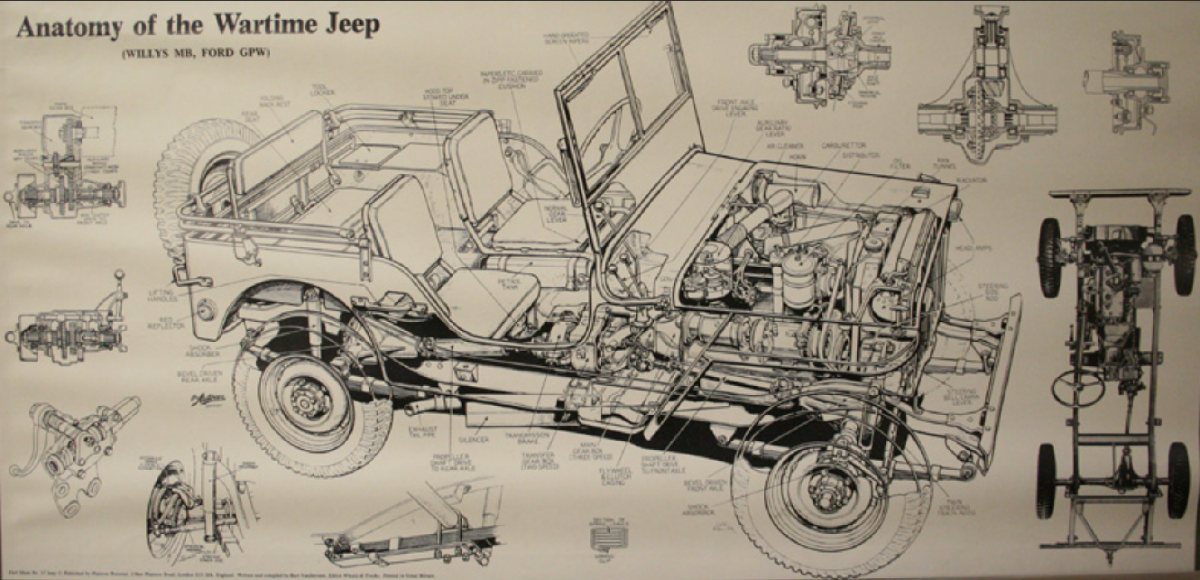

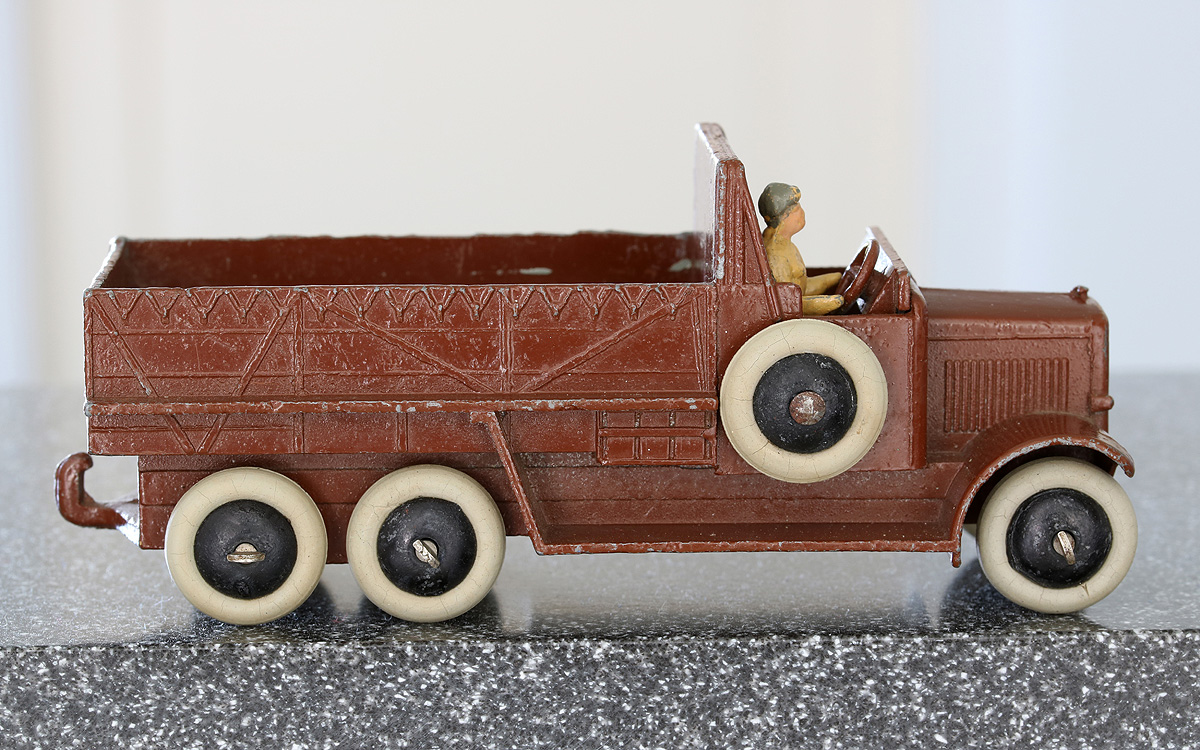


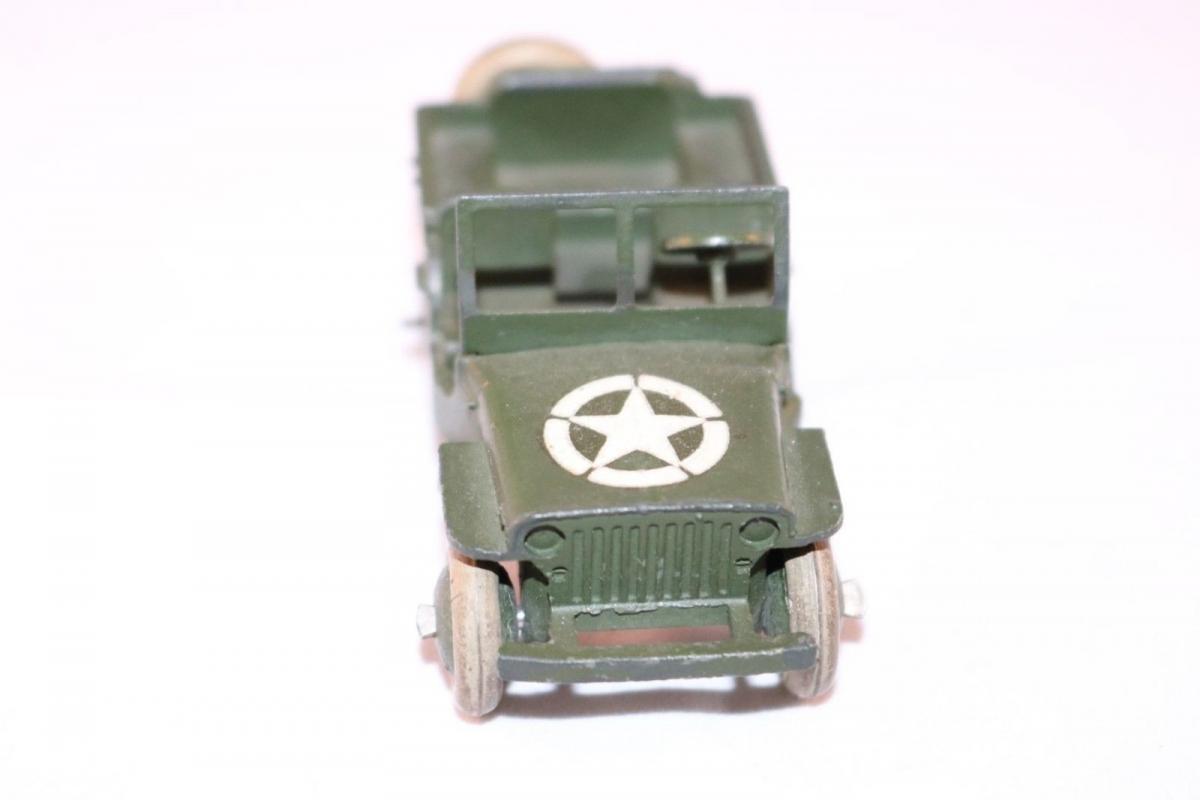
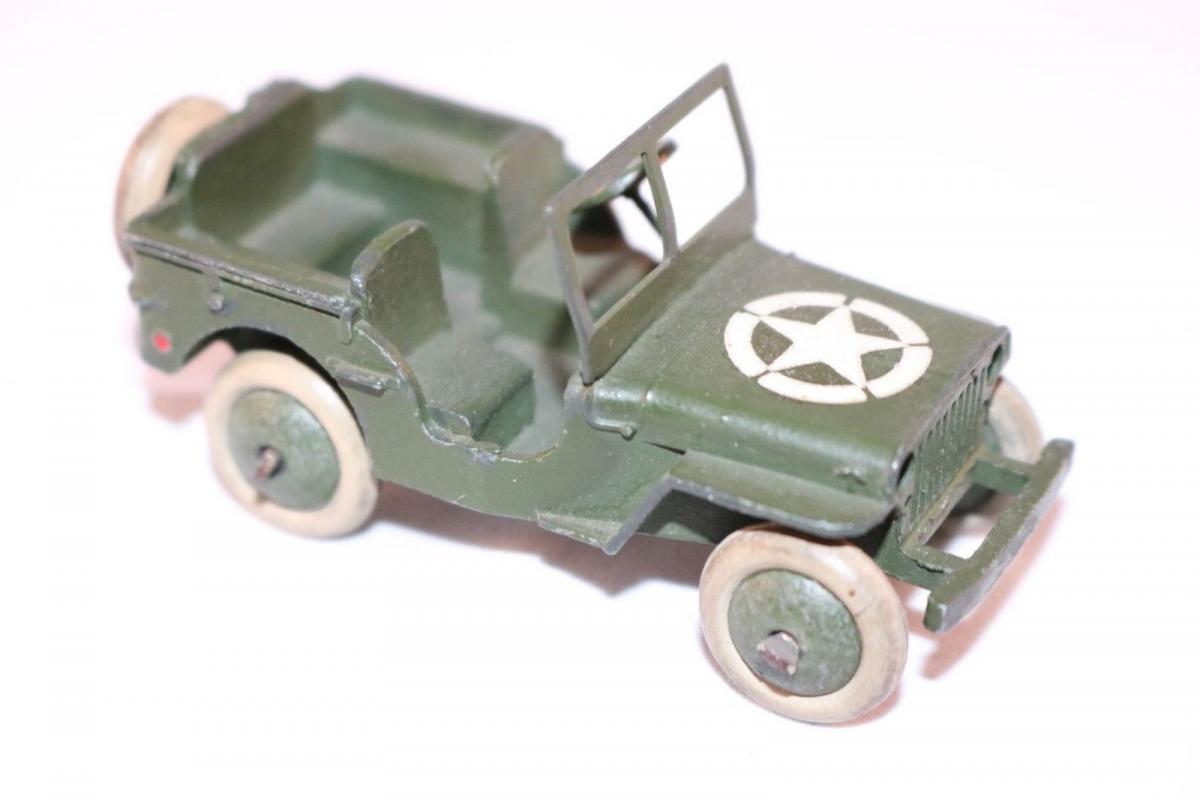
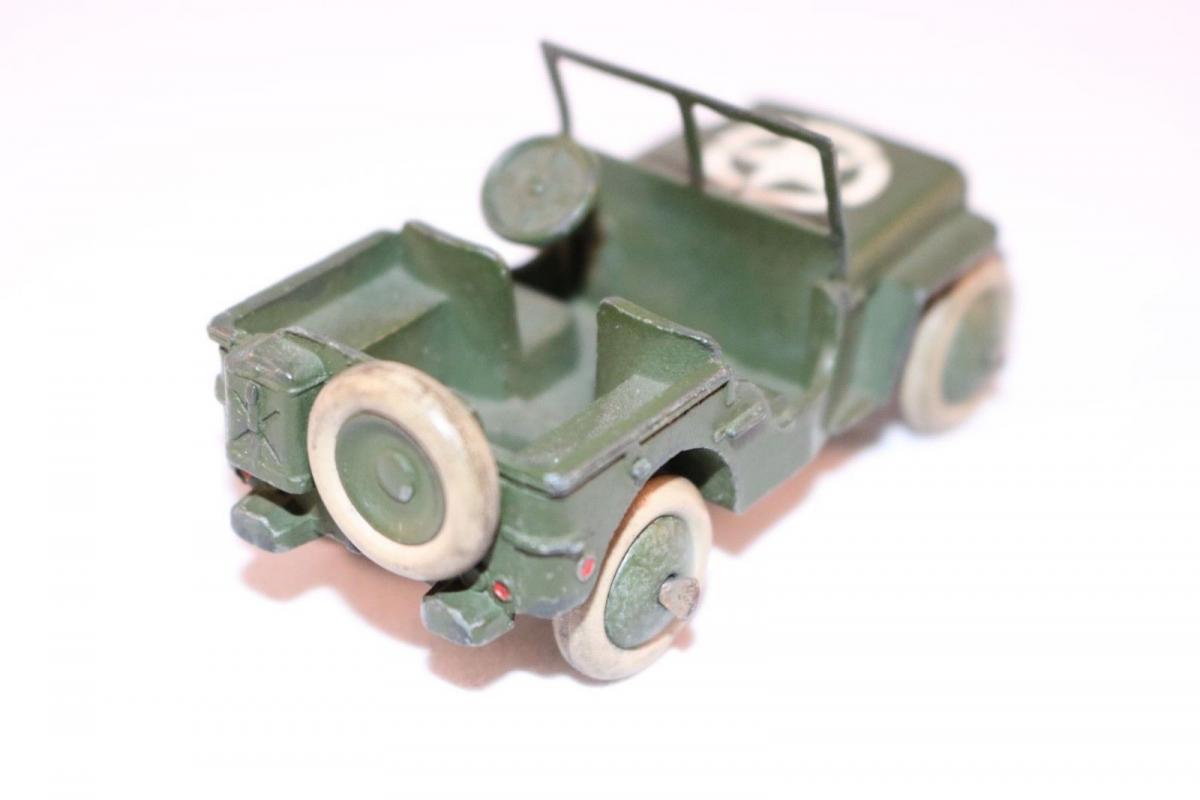

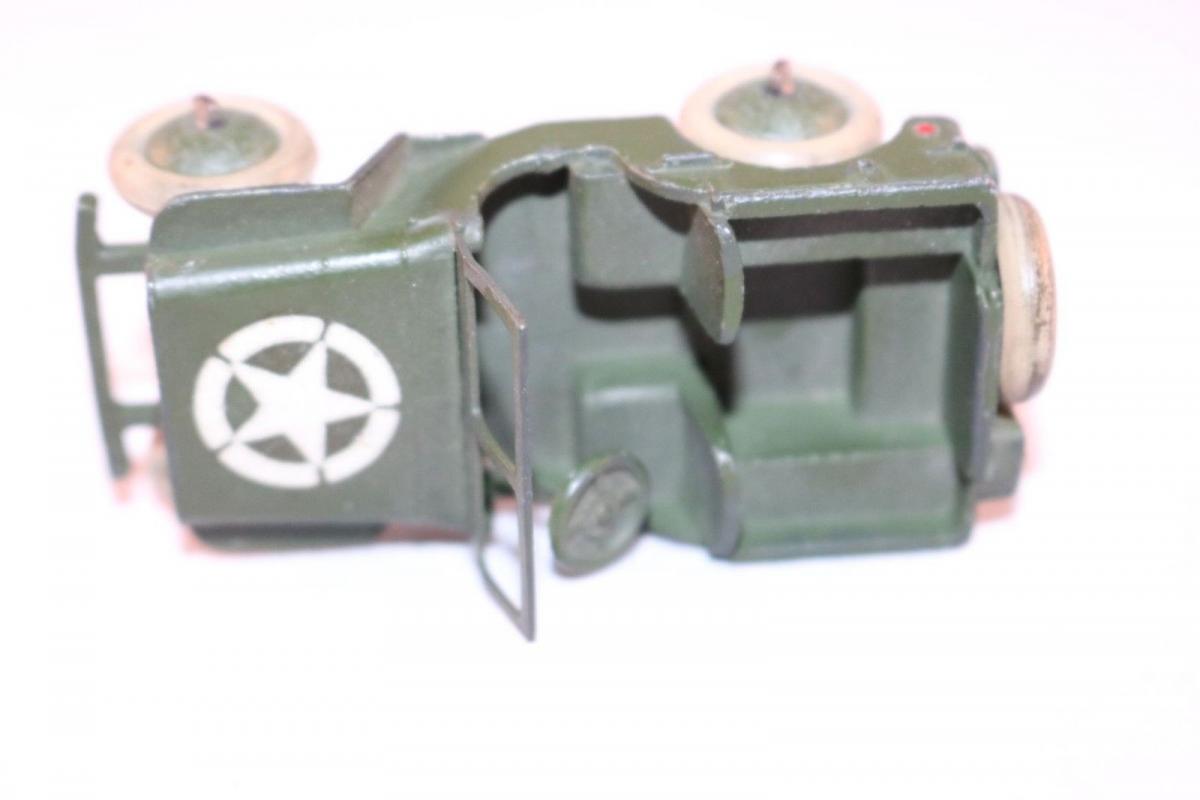

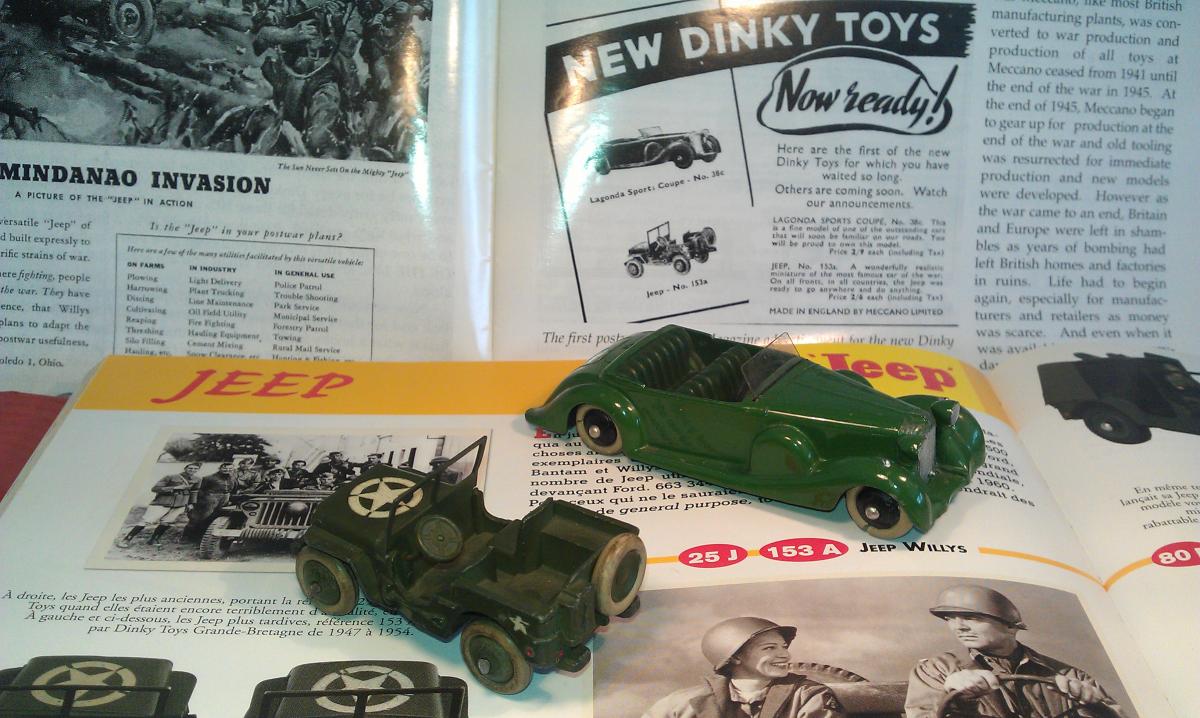
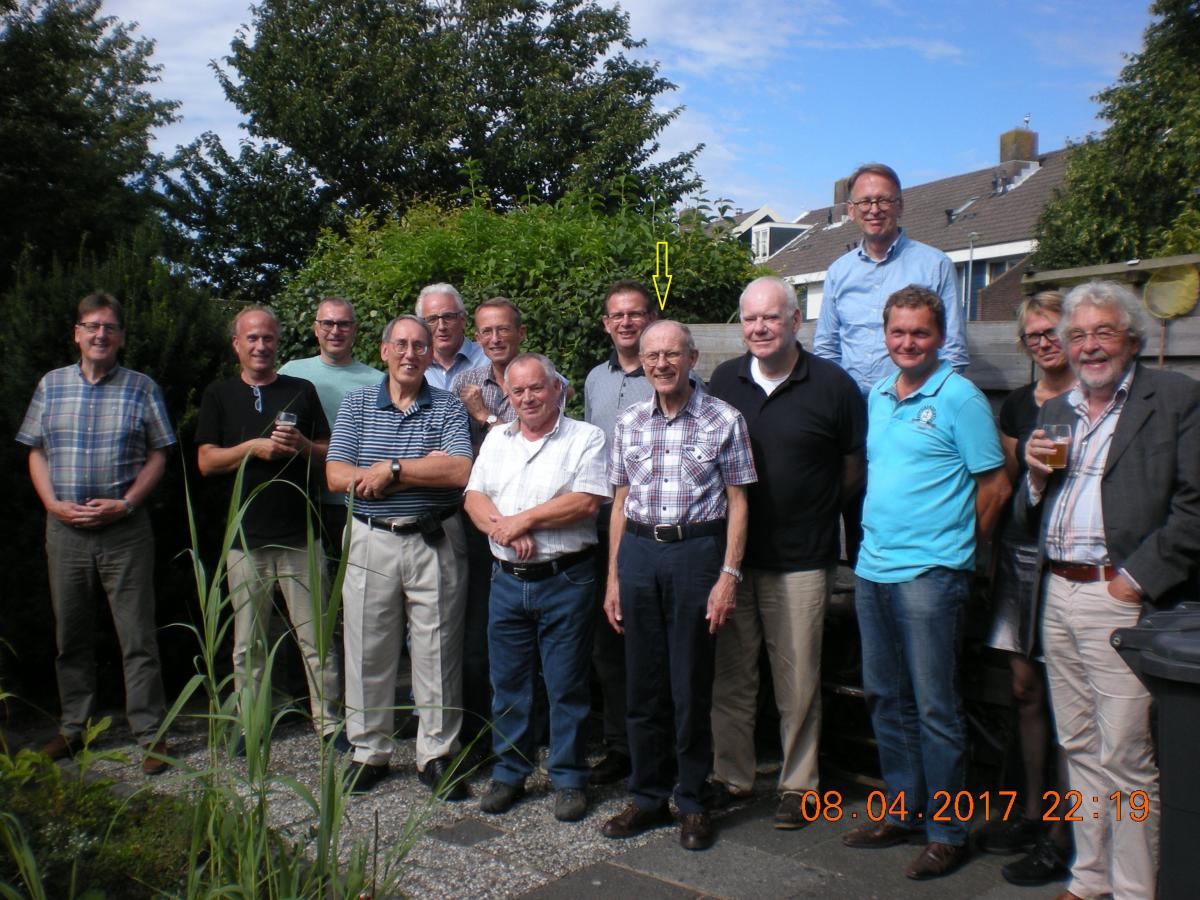
-105c and 383 4-Wheel Hand Truck (1949-1958)
-105c and 383 4-Wheel Hand Truck (1949-1958)
DTCAwebsite upgrade 2023
DTCAwebsite upgrade 2023
DTCAwebsite upgrade 2023
DTCAwebsite upgrade 2023
DTCAwebsite upgrade 2023
DTCAwebsite upgrade 2023
DTCAwebsite upgrade 2023
DTCAwebsite upgrade 2023
DTCAwebsite upgrade 2023
DTCAwebsite upgrade 2023
DTCAwebsite upgrade 2023
DTCAwebsite upgrade 2023
DTCAwebsite upgrade 2023
--22c Motor Truck (1933-50)
--22c Motor Truck (1933-50)
DTCAwebsite upgrade 2023
DTCAwebsite upgrade 2023
Trailer Caravans
Trailer Caravans
DTCAwebsite upgrade 2023
DTCAwebsite upgrade 2023
DTCAwebsite upgrade 2023
DTCAwebsite upgrade 2023
Trailer Caravans
Trailer Caravans
-138 Hillman Imp (1963-73)
-537 Renault 16 TL
-189 Triumph Herald Saloon (1959-64)
-255 Mersey Tunnel Police Van (1955-61)
DTCAwebsite upgrade 2023
-189 Triumph Herald Saloon (1959-64)
-189 Triumph Herald Saloon (1959-64)
-674 Austin Champ (1954-71)